The police department in Gardner, Kansas had locals reporting a mountain lion roaming Celebration Park in the city. After setting up cameras on a trail because of their concerns, they were “Glad to report that over the time they were up we did not see a mountain lion,” as their Facebook post stated.
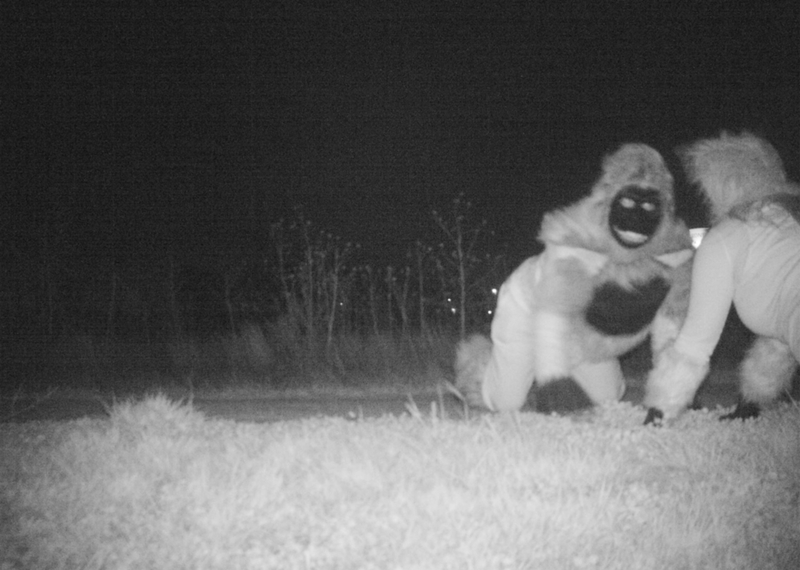
“We were however surprised by some of the images that the cameras did take.” It would appear a handful of residents found the cameras and decided to have some fun with them. If these black-and-white horror gorillas freak you out, you’re not alone, these photos are pretty strange.
Buck With a Hat
If you think your hat is weird, here's a new standard for comparison. Just take this young buck for example. His antlers caught a tumbleweed and now that means he's wearing a strange hat, and while it may look like a lovely crown to have, he can't seem to get rid of it.
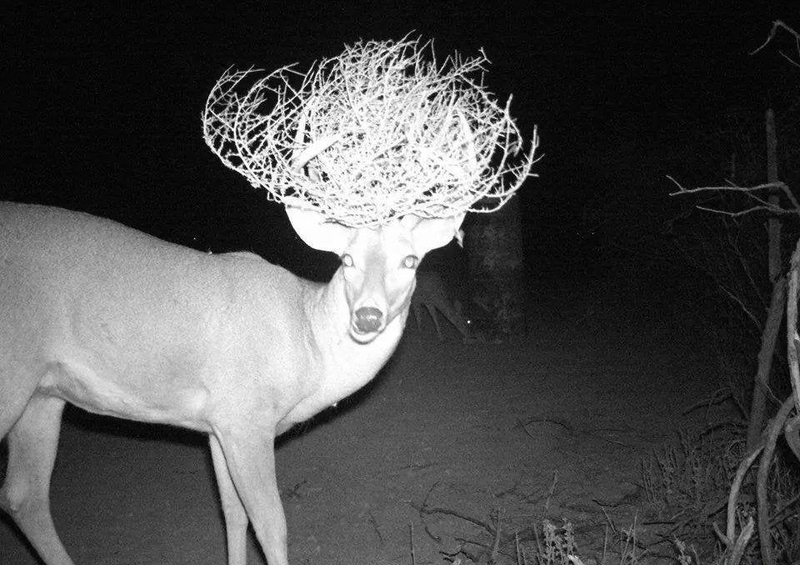
We've all had our struggles, but as humans, our issues are quite unlike that of wild animals. For one thing, we'll never know what it's like to have a tumbleweed stuck in our antlers. We’re hoping he finds a deer mate that will help him get it off, either with his hooves or with his teeth.
Watch Out! The Bear Is Running AT Us!
How scary! This is one mean-looking bear and we haven't even mentioned how big and powerful it is. Imagine it was running right towards you while you were spending a day outdoors. It sure is a good thing that this bear is caught on camera and not seen in real life.
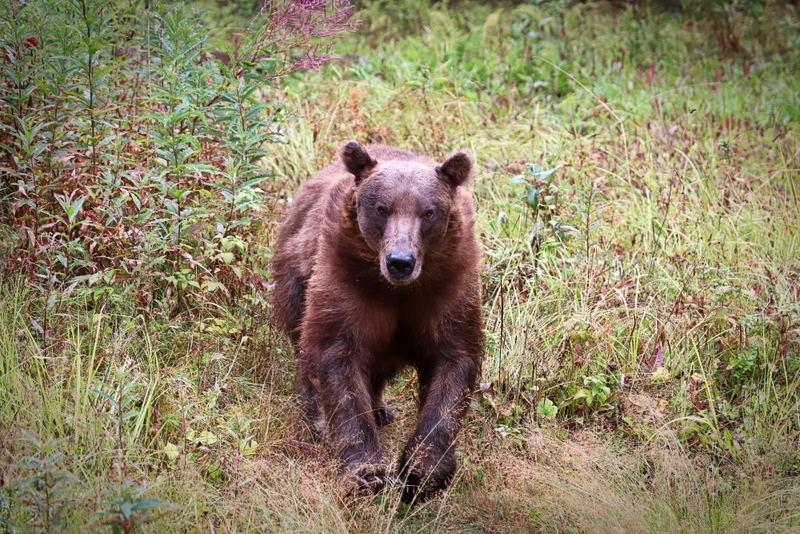
From the looks of it, it appears as if the bear is walking right toward the camera. Maybe it can see the shiny lens and wants to take a closer look. It's pretty cool that we live in a time where we can capture this kind of footage on camera.
Scary Sheep
There really is nothing worse than unexpected company when you're not in the mood. So, imagine the agony of having 200 uninvited and very confused guests just show up at your house one night... While sheep are not actually, particularly frightening animals, this picture of so many with glowing eyes looks pretty scary.

Luckily for us all, he knew exactly what to do in such a situation: get it all on camera. The flash of the trail cam probably caught their attention, which is why they are all just staring at the camera. This truly is a rare sighting, but at the same time also a little creepy.
Otterly Adorable
This little critter is 'otterly' adorable! We're not exactly sure what it's trying to do, either it's drying itself off in the leaves, making a nest, or giving the camera a show. Considering that otters are generally quick and sly, trail cams are so worth it for footage like this.
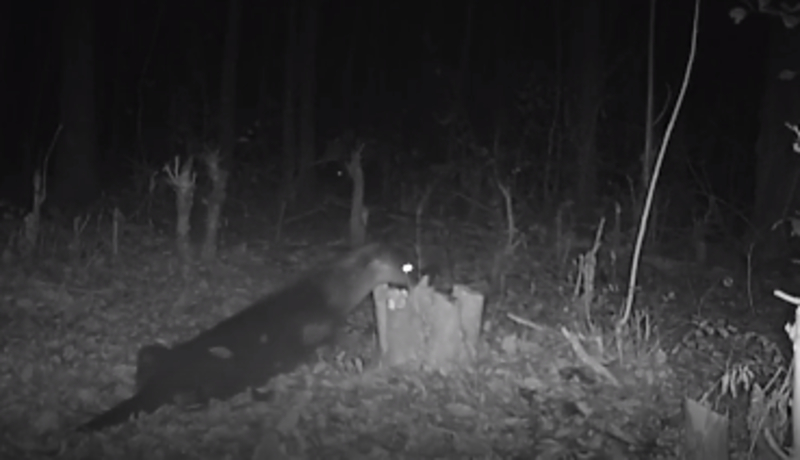
We don't often see them playing outside the water like this but what we do know from nature documentaries, they are known for their playful behavior, and this image proves that. It can be entertaining to watch them fumble around the water so it's pretty special to see it on the ground as it scatters the leaves.
Owl Strike
How amazing is this picture of an owl which is about to strike this deer? Owls are fairly shy creatures and we don't often see this at this close an angle, so it really is a rare find. This deer probably didn't even see this owl swoop down and attempt to grab his antler.

It's likely that this owl is unaware that its target will be a little too heavy to pick up. It should probably target a smaller kill, considering the size of its tiny mouth. Perhaps the deer got in the way of something else the owl was trying to take? Ill-timing!
Eagle Fight
This photo of two eagles battling it out right in front of a trail cam is mind-blowing. Capturing one eagle on camera is very special. But capturing two bald eagles wrestling over a carcass?! Now that's rare! Eagles are known for being aggressive and will often defend their territory from other eagles or predators.

It's quite remarkable that this trail cam managed to capture such a perfectly timed action shot. We certainly wouldn't want to face one of these, with their sharp talons and curved beaks. If anything, this footage makes it pretty clear that these apex predators are not to be trifled with.
Flying Squirrel
Flying squirrels are quite common and can be found in many parts of the country, but because they are nocturnal, few people ever see them. Flying squirrels have a membrane or fold of skin that spreads out on both sides of the squirrel's body allowing it to glide between tree branches.
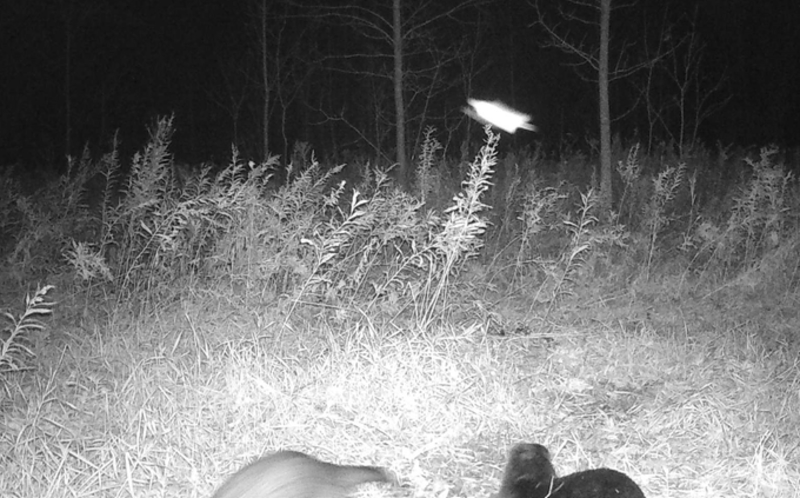
This trail cam captured a squirrel flying over two otters. Perhaps the squirrel thought these otters were just another branch it could jump over. It’s unclear whether the squirrel is about to pounce on the otters or if it’s just flying away, but one thing that is clear is that the trail cam caught the perfect moment.
Raccoon Selfie
A few times a century, a camera manages to capture an amazing photo that's both hilarious and adorable. More often than not, it's taken by a person who just happens to be at the right place at the right time. And we're thrilled to report the newest addition: this little raccoon, only this time it was captured by a trail camera.
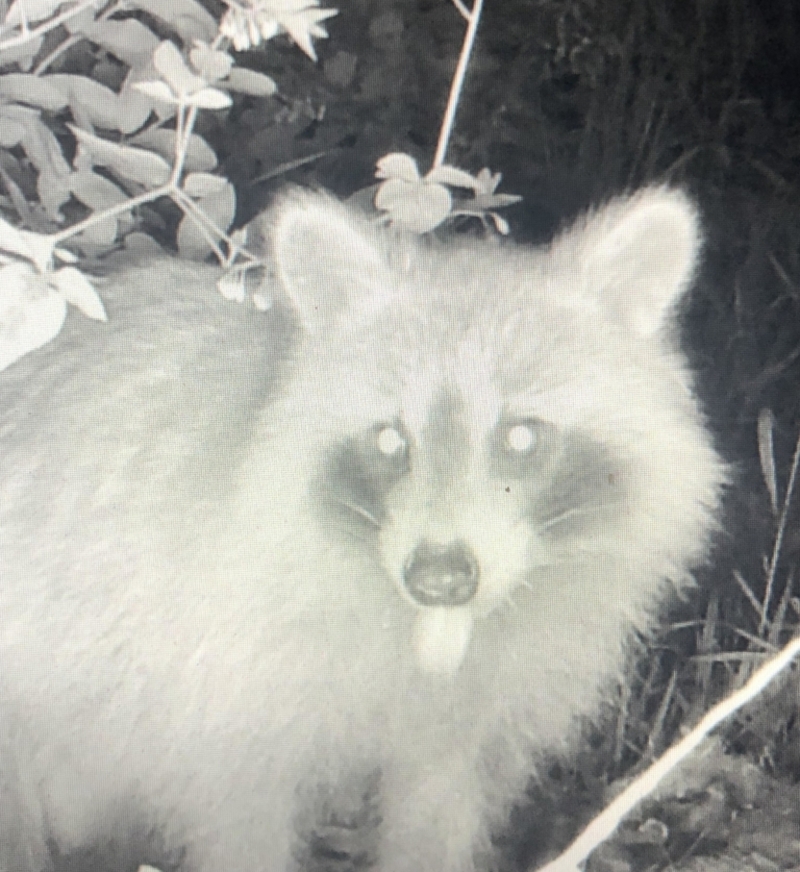
The furry daredevil may have just been looking for some food or passing by while it was finding a place to rest but somehow it was captured right as he was sticking out his tongue. This nocturnal creature must have hilariously surprised whoever first opened this camera.
Raccoon Cowboy
This little cowboy was enjoying a joyride on a wild hog near a feeding ground. If we didn't know any better, we'd say this looks like the American version of "Lion King's" Simon and Pumbaa. It looks like these raccoon rascals are becoming so smart, they're starting to domesticate other animals.
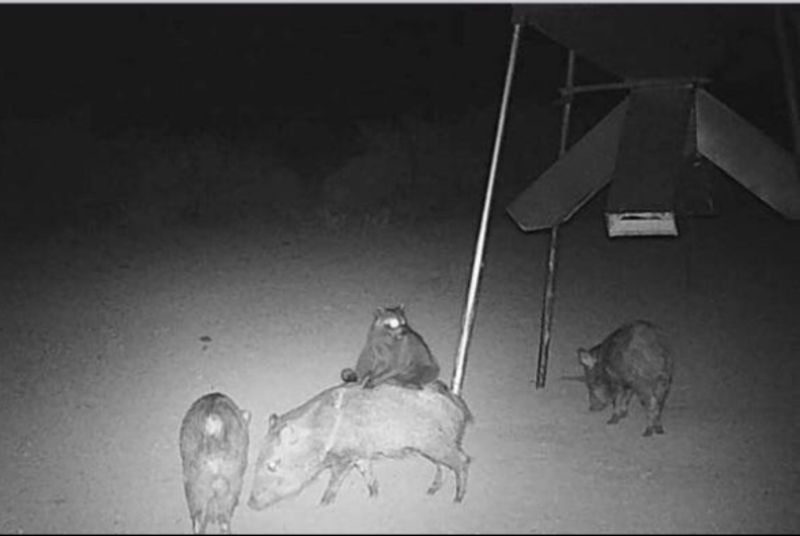
Nature does have a way of surprising us, especially in ways we least expect. To give credence to the popular children's story we all know as "Lion King", it seems that some species do befriend others! And with the help of trusty trail cams, we can now prove it.
Raccoon Party!
Sometimes it's good to be a raccoon! These raccoons look like they struck gold as they lay flailing about. Raccoons are social animals and can often be found congregating in groups. Two of these raccoons are relaxing in the snow while the others are living it up and enjoying the heap of whatever food they found.
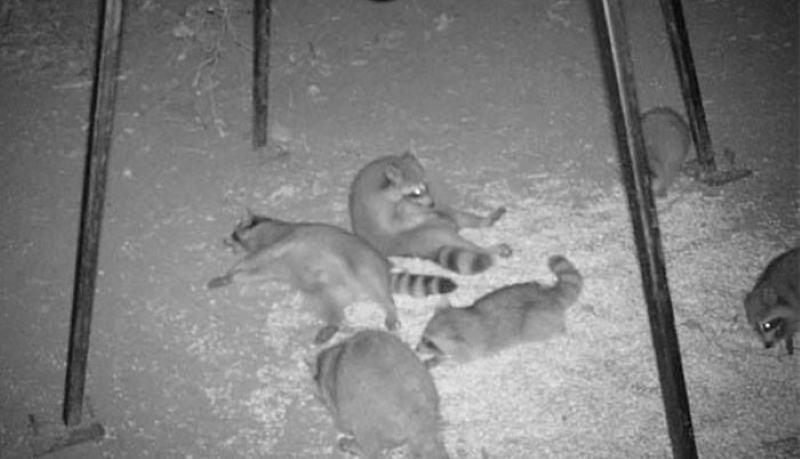
It seems like they have a long night of celebrations ahead of them, eating and sleeping throughout. We bet that these gatherings can get noisy, especially considering how playful raccoons can get. Now that sounds like a party we want to be invited to!
Curious Fox
The trail cam caught this super cute fox that appears to be surprised by it. Have you ever caught a curious fox in the act? Maybe you were walking in the woods, minding your own business, when suddenly you noticed a pair of beady little eyes watching you from the bushes.
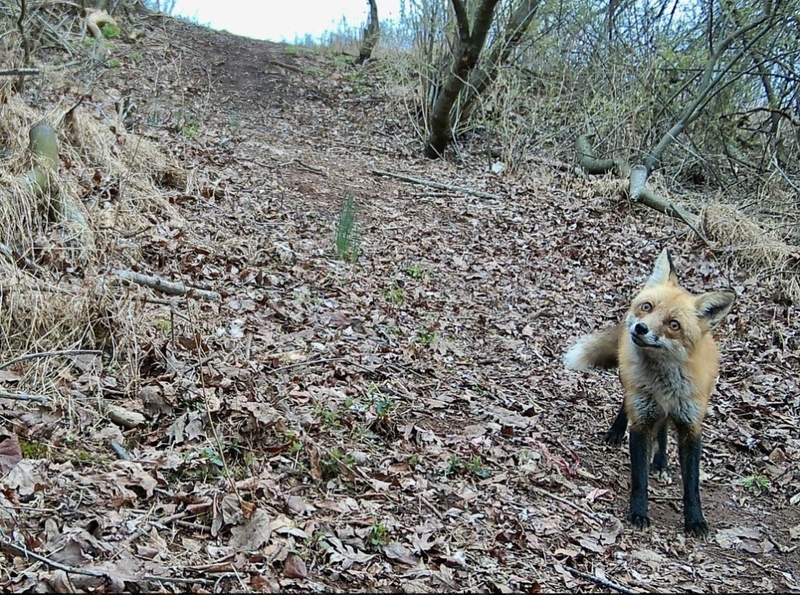
Or maybe you woke up one morning to find your garbage cans knocked over, and a sly little fox skulking away with a chicken bone in its mouth. One thing's for sure — these furry little troublemakers are adorable and their curious nature gets them into a lot of trouble.
Is That Bigfoot?
Let's be honest, we've all been fascinated by the legend of Bigfoot at some point in our lives. With his massive size, shaggy fur, and mysterious nature, he's like the ultimate celebrity of the cryptid world. But have you ever stopped to think about what it would be like to actually encounter him in real life?
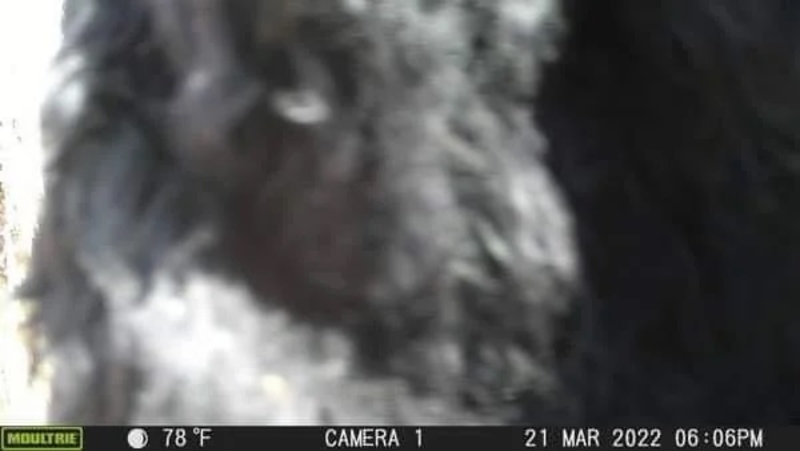
First of all, can you imagine the shock of actually finding camera footage of this towering, hairy creature in the middle of the forest? It's enough to make your heart race faster than a sprinting Sasquatch. Perhaps the most amusing part of encountering Bigfoot would be the inevitable social media frenzy that would ensue.
Coyote Deer Stand-off
This incredible photo captures what looks like a coyote trying to fight off two deer. It looks ready for action as it's baring its teeth and in a position that suggests it's about to pounce. The deer, on the other hand, seem curious about this strange critter. We don't think they've realized yet that it could be a threat.
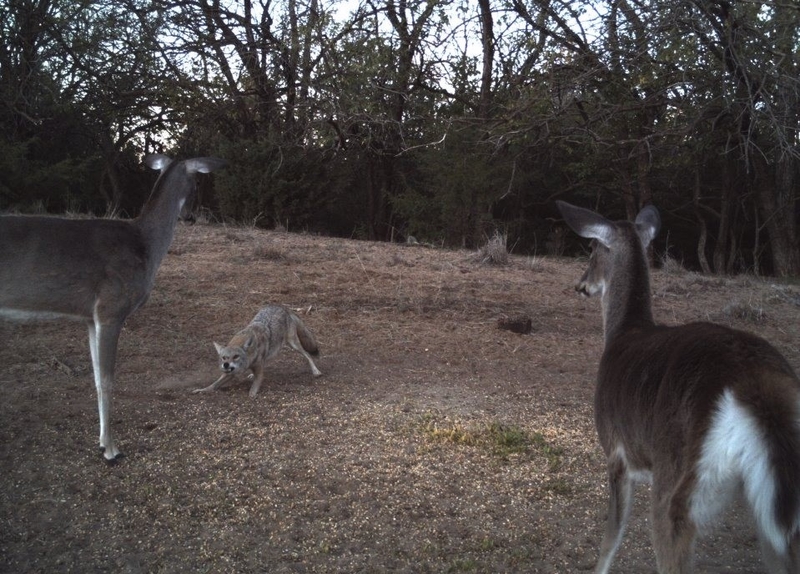
It's an amazing shot that was probably taken a few seconds before action. Typically, coyotes don't prey on deer this size but they are opportunistic hunters and will hunt a wide variety of prey. However, this coyote is probably not big enough to take down a deer of this size.
Broken Camera
Oh dear, did this woodpecker mistake this trail cam for something to peck? Woodpeckers are known for their ability to peck and drill into wood using their strong beaks. There are over 200 different species of woodpeckers, so could it be that this is a new species of bird called the “camera-pecker”?

It's so close it must be inspecting the lens to see why it's so shiny. Perhaps it thought it'd find some kind of treat inside. Woodpeckers use their beaks to forage insects and also to drum on wood to communicate with other woodpeckers. It's quite fascinating that there aren't many other creatures who communicate this way.
Muddy Tiger
This tiger is drenched in mud, probably as a means of cooling itself from the boiling sun. Tigers are known to sit in mud or water to regulate their body temperature on hot days. We're not used to seeing tigers like this — it almost looks like it's wearing a bathing suit.

Tigers have adapted to living in warm and humid environments but they also have thick coats of fur. In case you didn't know, tigers are one of the few cats that actually enjoy swimming. Most cats are uncomfortable in the water and will go to great lengths to avoid it.
Raccoon Riding a Feral Hog
Breaking News: Raccoon Spotted Hitching a Ride on this wild hog! In a surprising turn of events, a raccoon was spotted hitching a ride on the back of a boar in the forest. The raccoon was seen clinging to the boar's back with a determined look on its face as the boar charged through the underbrush.

The boar, on the other hand, was reportedly unfazed by the raccoon's presence and simply continued on its way, occasionally grunting in what some speculate to be approval. We're not sure if this is a new trend or just a one-time occurrence, but we're definitely keeping an eye out for any other unlikely animal pairings. Who knows, maybe we'll see a squirrel riding a deer next!
Giant Deer Buffet
It looks like the deer family might be celebrating a special occasion as they feast in the middle of the night. We were quite surprised to find out that deer are actually nocturnal and they only occasionally venture out during the day. They don't seem too happy about being disturbed, though.
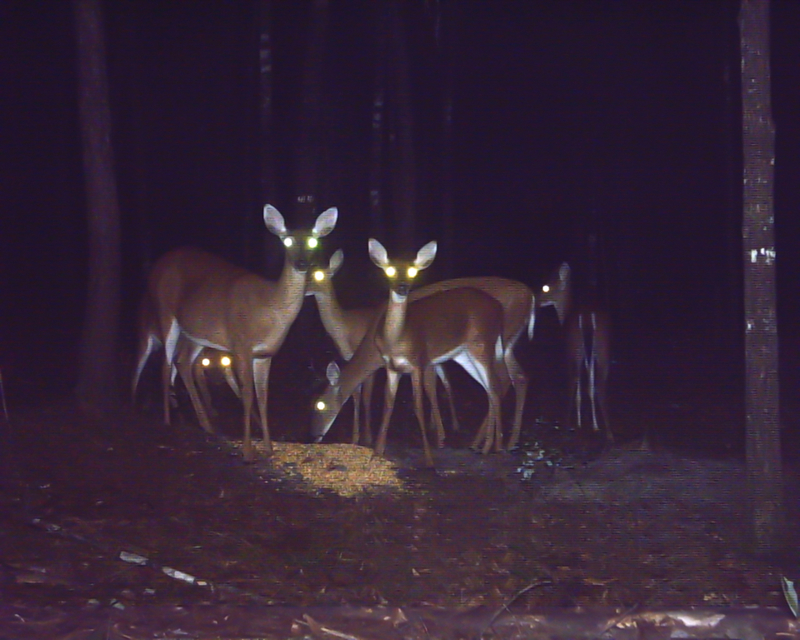
The white-tailed deer, like other wild deer, is herbivorous and feeds on a variety of plants, grasses, sedges, leaves, and shoots of trees. They were probably happy to find something different on the menu. It looks like it was set up in front of the trail cam to see what animals are roaming through this wooded area.
So Who's the Thief?
Possums are often considered "rascals" because of their mischievous and cunning behavior. Here we have proof of that behavior in the form of this picture of them enjoying grapes in someone's garden. It's important to note that these behaviors are natural adaptations that have helped them survive in their changing environment.

Possums are nocturnal animals that are often active at night as we can see, and they have adapted to be very good climbers and scavengers. This little fella probably thought it'd struck a gold mine when it found these grapes on a vine. However, the owner probably wasn't too pleased.
A Passel of Wild Hogs
Have you ever heard of a wild hog party? Well, let us tell you, it's a sight to behold! Whoever owns this trail cam was in for a pleasant surprise when they saw the footage from their latest tape. He found a whole passel of wild hogs, grazing close to his backyard.

Most of the time, it's difficult to find this large of a group. So if you're ever out in the woods and hear a bunch of grunting and squealing, don't be afraid. It might just be a passel of wild hogs, quite similar to this, having the time of their lives.
Creepy
So apparently, there are scarier things in the wild than just wild animals. We are not sure what in the world is the animal that was caught riding this wild board. How did it get here, and what is it doing hitching a ride in the middle of a forest?
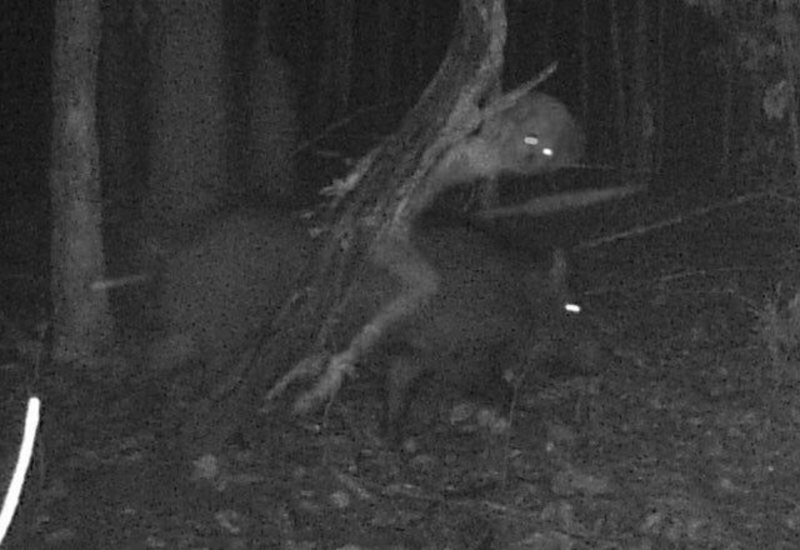
When looking a little harder, it almost looks like it could be hanging from the tree. Whatever it is and whatever it's doing, we don't really need to know, it's not going to change the fact that it's by far the creepiest thing we've seen so far, and we've seen some scary stuff!
Cougar Time
This cougar looks like it's been hitting the gym and now has boulders for shoulders! This trail cam took this footage in Northern Alberta during the summertime. Finding a cougar on a trail cam can be exciting for wildlife enthusiasts or researchers as it provides an opportunity to observe these elusive creatures in their natural habitat.

Cougar sightings are relatively rare, and trail cams can capture images of cougars without disturbing their natural behavior. However, it's essential to remember that cougars are wild animals and can pose a potential danger to humans. So, if you come across a cougar, it's best to give it plenty of space and avoid any sudden movements or loud noises.
Grooming Session
Did this trail cam just catch an intimate moment between these two deer or was it a mere lick to clean off some leaves that got stuck on the other deer's ear? Deer are known to groom themselves by licking and cleaning their fur with their tongues. However, it is not common for deer to groom each other as a social behavior.
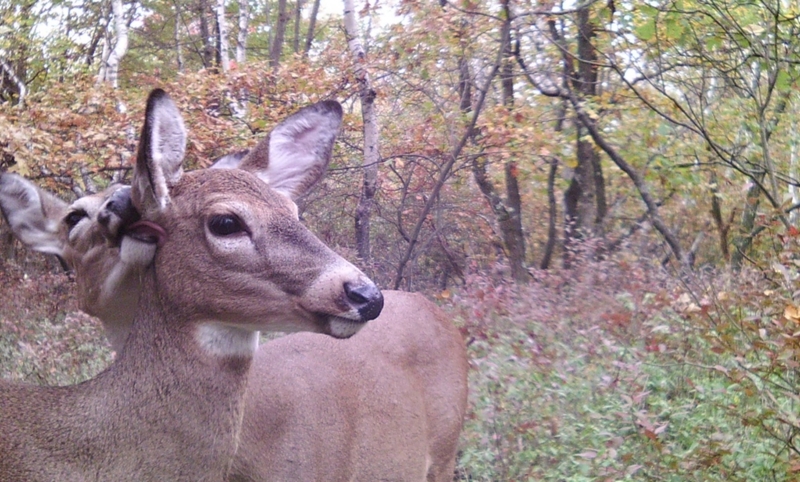
Deer are generally solitary animals and unlike other mammals, they do not form social bonds or groom each other. This is quite an unusual sight captured on camera. Perhaps these two deer have formed some kind of bond? What else could explain their grooming?
Bird Beak
Some birds, such as this heron, are known for their ability to eat relatively large fish despite their small size. Herons have long, sharp beaks that are designed to impale fish and hold on to them. The beaks are also serrated, allowing the birds to grip and tear flesh from the fish.
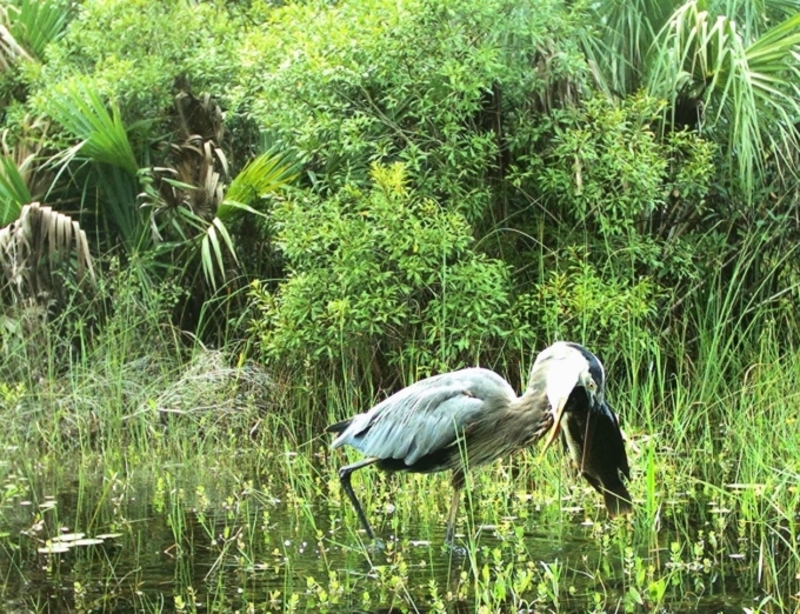
Despite the small size of their beak, these birds are some of the most impressive hunters in the animal kingdom! It's pretty cool to see footage of this remarkable accomplishment. Well, as remarkable as it is to us, it's probably just another meal for this beautiful freshwater heron.
Standing Wolverine
Did you know that Wolverines, which are a type of mammal in the weasel family, are capable of standing on their hind legs? We didn't know that until we saw this photo! This behavior is usually used when they are trying to reach something, such as food, or to climb up a steep slope.

However, it seems here that this guy is just trying to get a better view. Wolverines are very muscular carnivores, they resemble small bears more than anything. Wolverines have quite the reputation for being ferocious and for having strength that is way out of proportion in comparison to their size.
Giant Moose Coming Through
This moose looks almost like he's ready for his close-up. He's staring directly at the trail cam, almost as if he's trying to strike a pose for it. It's not quite 'Blue Steel' but he'll get there one day. For now, he should probably just focus on getting enough nutrients for the cold winter.

As the largest member of the deer family, a male moose can stand over 6.9 ft and weigh over 1,400 lb. If it was just us guessing, we'd say this guy looks pretty big. Even though moose aren't known for being aggressive, we certainly wouldn't want to face this guy alone in the woods.
Gator vs Raccoon
Trail cams are set up in remote locations, like this swamp out in Florida, to find some unpredictable footage. From the description, this raccoon was hanging out for a while on the bait tray eating some dinner when the gator thought the raccoon looked like HIS dinner! He pounced and almost caught him.

Fortunately, this is one lucky raccoon and it was able to get away without being eaten. As this raccoon has probably noticed, it's essential to respect other predators' habitats and avoid getting too close. If you happen to encounter an alligator, it's best to give them plenty of space and avoid any sudden movements or loud noises.
Deer Running
Everybody you know is going to the Jersey Shore or Miami Beach for their vacation, but you'd rather spend your time in the great outdoors. Getting the chance to spot some wildlife is what you'd much rather be doing than waiting in line for a slushy with other sweaty people. That's probably why trail cams were set up in the first place!

This trail cam captured a deer as he was running away from a shot fired. Now, finding a deer running on a trail cam is not that remarkable. However, finding a deer running while we can still see the smoke from the shot is pretty rare. While we're not sure if the deer was shot or not, this footage tells a story.
A Late Thanksgiving
Raccoons are instinctively adventurous, curious, and highly adaptive creatures. This nursery of raccoons had a family gathering in someone's yard. A late Thanksgiving perhaps? There are three in this photo taken by a motion-triggered trail camera. Of course, we don't know if there were more outside the view of the camera.

We're pretty sure their antics definitely woke someone up way before their alarm went off. Especially considering the fact that urban environments are practically a training ground for raccoons! With so many more options to forage, from garbage cans to bird food, these raccoons have lots to choose from.
Kung Fu Fighting
It’s so cool when the camera catches a squirrel right in front of it. Especially when it's a Kung Fu fighting squirrel. It looks like this little guy spent hours practicing his moves, watching Kung Fu movies, and dreaming of becoming a true master of the art, just so he can deliver this master kick.
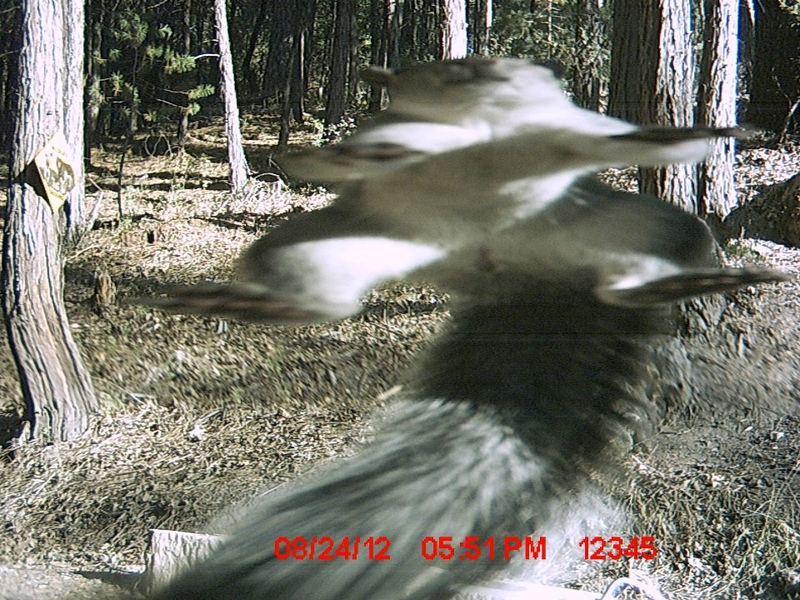
From that day on, this squirrel became known as the Kung Fu fighting squirrel, and his legend grew throughout the forest. He finally found his true calling and taught other animals the ways of martial arts, and soon they too were able to defend themselves against any bully that came their way.
Tasting the Camera
What an adorable picture of this deer who has come to see how the camera tastes! Is it as tasty as it is shiny? We wouldn't think so, but that didn't stop this deer! Deer are known for being curious animals and are keen to investigate their surroundings, for better or worse.

Hopefully, she's not so curious that she decides to eat the camera lens. It could be that this camera might be camouflaged with leaves and branches. It might be tempting to wait, but it wouldn't be as tasty as it looks, plus, nobody would be happy if their expansive camera was someone's lunch.
Buck Wild
These two deer are getting buck wild smack in front of the camera. They must be fighting over a doe or some nearby territory. Bucks typically fight each other during the breeding season, which is also known as the rut. This period usually occurs in the fall or early winter.

The fights between bucks can be violent, with the animals using their antlers to push and shove each other in an attempt to establish dominance. This fight would be pretty wild to watch in person, but at least we can catch a glimpse of it in this action shot! It sure looks tense!
That's a Ringtail!
This strange-looking creature is a ringtail, sometimes called the ringtail cat or miner's cat, and these critters are actually part of the raccoon family native to North America. They're a pretty rare sight to see as they are mostly nocturnal and spend most of their sunshine hours sleeping in their dens.

Ringtails are very cute and interesting animals, known for the distinctive black and white rings on their tails. They have grayish-brown fur on their back and along their sides, with a cream-colored underbelly. They also have dark patches around their eyes, which may help to reduce glare when hunting at night.
Yikes
If we didn't know any better, we might suggest this is footage of a skinwalker. Skinwalkers are legendary creatures in the Navajo culture, and there are many different beliefs and stories about them. According to Navajo tradition, skinwalkers are witches or shapeshifters who have the ability to transform into different animals, including coyotes, wolves, foxes, and owls.

In their human form, skinwalkers are said to have many unusual physical characteristics, such as long arms and legs, animal-like eyes, and unnaturally fast movements. Much like the thing in this photo. Skinwalkers are mysterious and feared creatures in Navajo culture, and encountering one is considered a rare and potentially dangerous experience.
Standing Deer
When a deer stands up on its hind legs, it sure is tall! Did you know deer are capable of standing up on their own? In fact, standing is one of their primary activities, as they spend much of their time browsing and grazing for food on trees and shrubs.

Deer have long, slender legs that are designed for running and jumping. They've adapted quite well to life in the wild and are able to quickly stand up from a resting or lying position if they sense danger or need to move to a new location. It could be that the sight of this camera set this deer on alert and that's why he's standing upright.
Deer Taunt
Is the deer making fun of us and sticking its tongue out? We can almost hear her giggle to herself as she pulls this funny face for the camera. Maybe she thought the camera would be a tasty treat and provide some variation to her diet of plants and grasses.
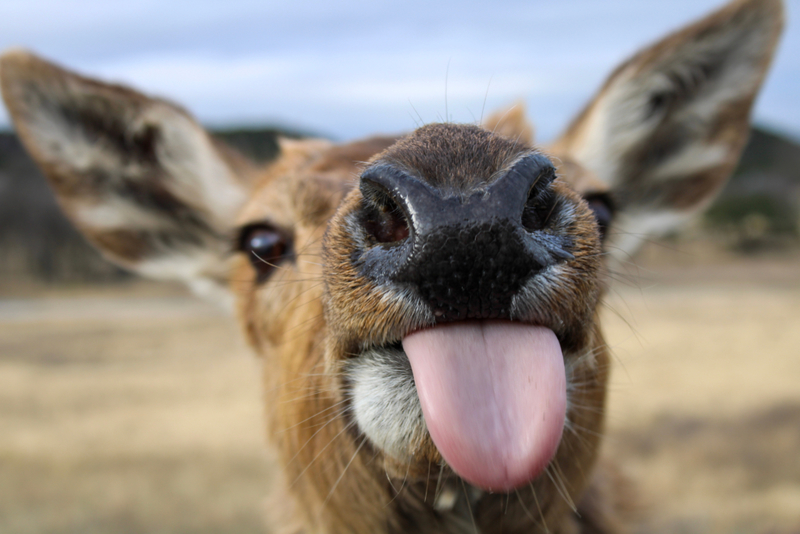
If this trail cam belongs to a hunter, this deer might want to watch where she places her tongue and instead run for cover. It sure makes for a silly picture though! Whoever found the footage from this trail cam was probably delightfully surprised to see this cheeky deer sticking out her tongue.
Cat and Fox
This trail cam captured this unsuspecting cat while a fox seems to be drawing closer to it. It is quite unlikely that this cat and fox would form a friendship. While both are carnivorous mammals, they have different instincts and behaviors that could prevent them from becoming friends.
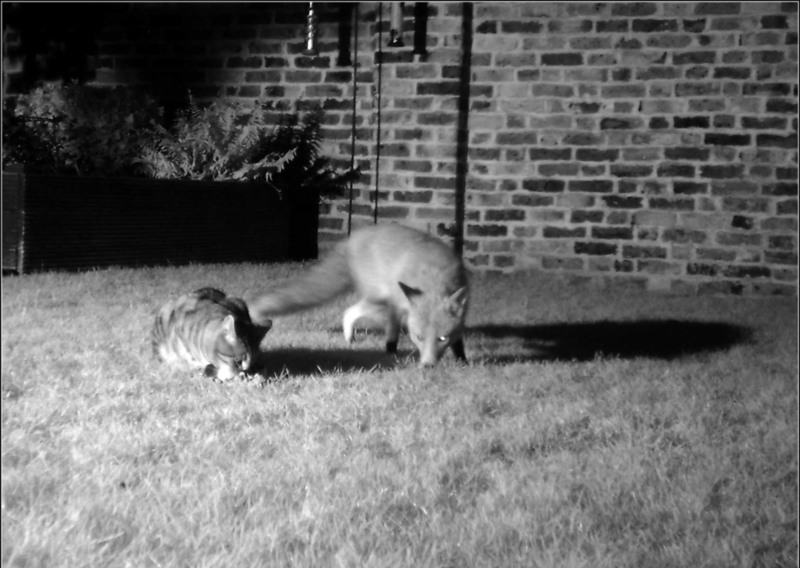
Cats are typically solitary hunters and may view a fox as a potential threat to their territory or food source. Foxes are social animals that may view a cat as prey or competition for resources. However, these two might just be getting used to each other enough to at least tolerate their presence.
Black Bear
This trail cam caught the perfect close-up of this black bear chomping on a snack. These impressive creatures can grow up to 6 feet tall and weigh up to 600 pounds! They are known for their sleek black coat of fur and their curious, playful nature. It's great seeing one this close.

But we certainly wouldn't want to encounter one in the wild. As cool as black bears are, it's important to remember that they are wild animals and should be treated with plenty of space, respect, and caution. Otherwise, you could be the snack this bear is chomping on next.
Howling
These howling animals are neither foxes nor wolves. They are coyotes, in their full glory. Coyotes are known for their howling, they do so primarily as a means of communication with other coyotes. Fun fact: Coyotes typically howl more frequently during the night due to the fact that they are more active at night and that their howling is more audible in quiet environments.
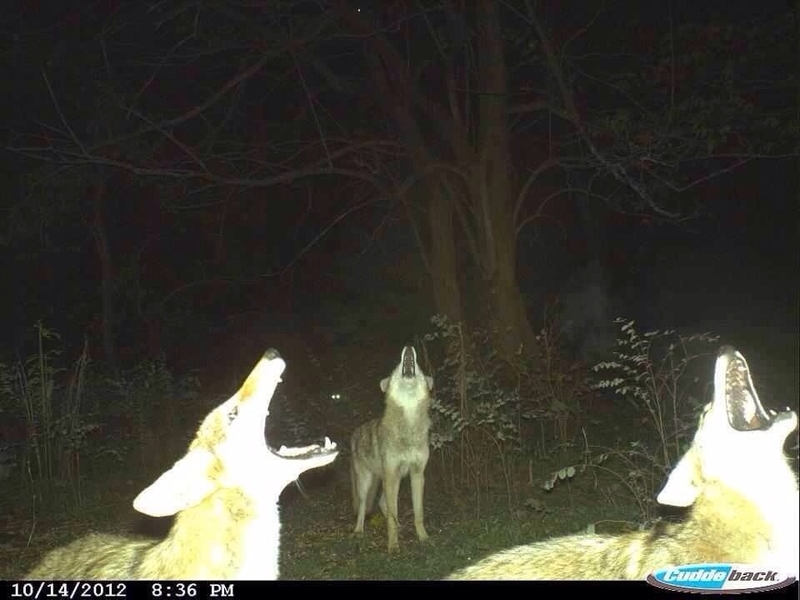
They sure look badass, howling in unison. Thankfully, someone caught it on their trail cam and shared it online. But coyotes are not the only animals that howl at night. Wolves, dogs, and even some bird species have been known to howl as a means of communication with their own species.
Bear With a Mouthful
Bears in North America are known to hunt fish during the salmon spawning season. Plus, bears are known to be good fishers, as you can see in this photo. That looks like a decent fish and this bear must be excited to eat his lunch, he's certainly earned it.
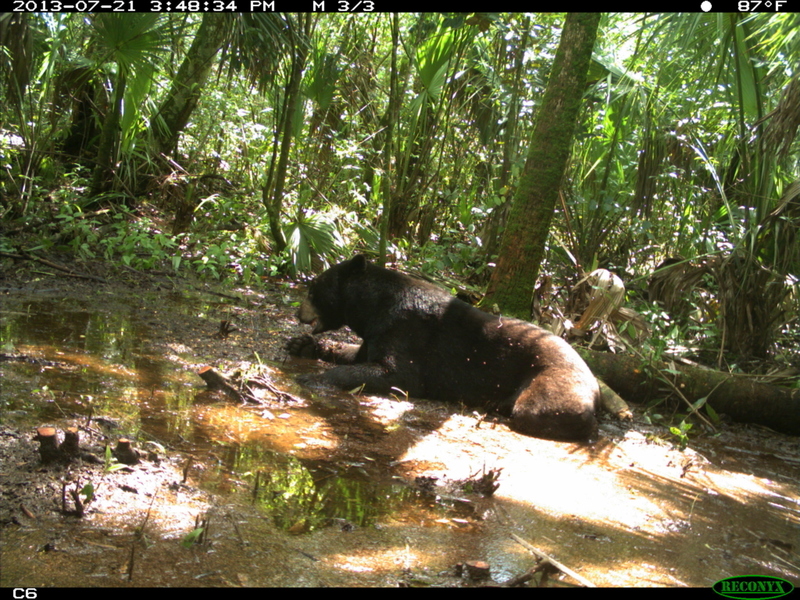
Being a bear in the wild can be challenging and definitely unpredictable. But it must be great to live wild and free. While it's probably much harder to look for nourishment, it must also be satisfying when you do manage to catch something. There's nothing like enjoying a meal you've worked hard to get.
Deer Stack
Life in the animal kingdom can get tricky. For one thing, competing for a mate sometimes means awkward love triangles can occur. Take these three deer in this photo: it looks like neither of these two male deer would take no for an answer, and when they saw their opportunity, they took it.
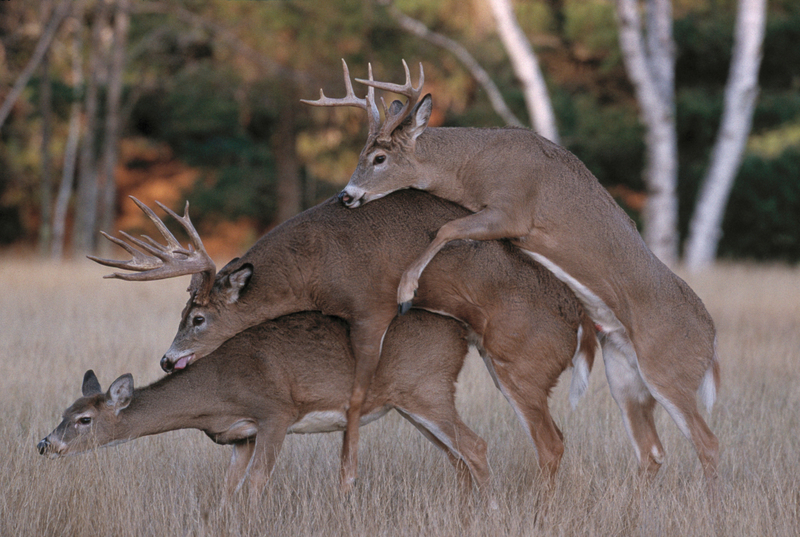
We think one of the deer might need to take a step back and wait his turn. Generally speaking, it's usually the most dominant buck that mates with female deer during the mating season, while less dominant bucks may not have the opportunity to mate at all. But as we can see, the deer at the back did not like that idea.
A Scary Sighting
What's worse than spotting one mountain lion in your backyard? Spotting two mountain lions in your backyard! You certainly wouldn't want to be alone when faced with these predators. If you are though, it's important to understand that mountain lions will only attack humans if they feel threatened or cornered.
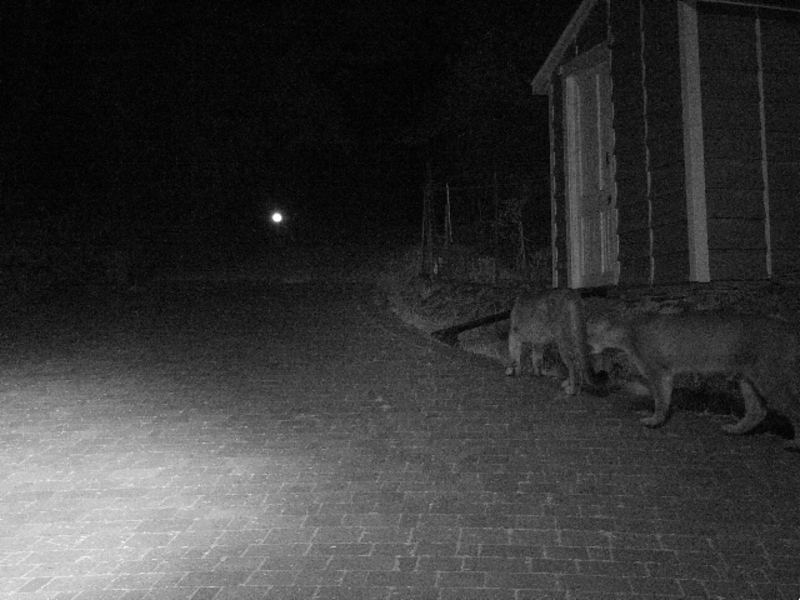
Try to make yourself look larger by raising your arms or holding a jacket above your head. Avoid crouching or bending over as this may make you look like prey. The last thing you want to do is turn your back on them or run away, as this may trigger their predatory instincts. Instead, slowly back away while keeping your eyes on the mountain lions.
Fighting Deer?
These two dear standing on their hind legs almost look like a pair of kangaroos about to knock each other out. We didn't really understand this so we did a little research into this strange behavior, we found that sometimes standing on their hind legs can be a defensive behavior for deer.

Deer may stand on their hind legs, although it's not as comfortable, to make themselves look larger and more intimidating. This can help to deter an opponent or predator and give them a chance to escape. This totally checks out, cause it sure doesn't look like a budding friendship.
Deer & Possum
This trail cam managed to capture a deer encountering a possum. They both just seem to be looking at each other, perhaps they're curious about what the other animal is and what they're doing in their territory. We would run if we were this possum because that deer is much bigger and could cause some serious damage.
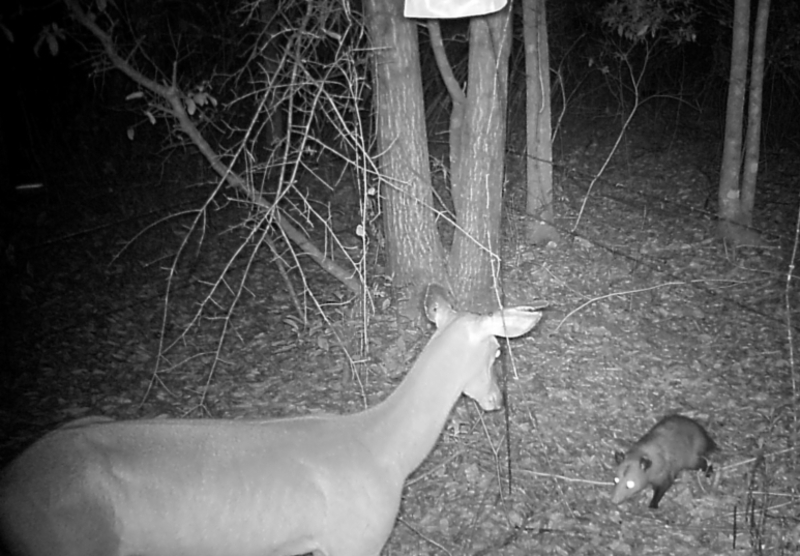
Then again, possums are known for dropping to the ground, remaining completely still, and even sticking out their tongues when confronted by potential threats. We'll never know what either of these animals did, but we sure know we wouldn't want to face an animal of any kind when it's this dark.
Otter Snack
Apparently, this otter took his little fish snack in front of the camera. How cute is he? River otters typically feed on fish such as trout, salmon, and catfish, as well as crayfish, crabs, and other small aquatic animals. As we can see here, this otter has sharp teeth for grasping and tearing his prey.

The person who took this photo was probably super excited by it. Otters are fascinating critters and they play an essential role in maintaining the health and balance of aquatic ecosystems. It cannot get any cooler than this little dude feasting on his food right in front of the camera.
Dancing Deer?
Could this deer be dancing? At first, we thought our eyes were playing tricks on us. But no, it was definitely a deer busting some serious moves. It's like this deer is in its own world, completely oblivious to everything around it. So there you have it, folks, deers enjoying dancing on their own.

Out of all the animals, we wouldn't imagine deer dancing, maybe birds, but not antelope. Next time you happen to take a hike in the woods, you could enjoy a perfectly normal stroll in nature or you could end up facing a dancing deer. Crazier things have happened, after all!
Mountain Lion On The Chase
This trail cam captured this mountain lion about to pounce on a boar. Can a mountain lion take down a wild boar? We're really curious cause boars are some of the toughest beasts in the woods so we wouldn't be surprised if this boar managed to get away. Then again, so are lions!

Apparently, this trail cam was set up in Florida, which must mean that this mountain lion is actually a Florida panther. What a stunning bit of luck! Florida panthers are critically endangered, they say there are approximately only 160 panthers left in the world, which only makes this shot that much cooler.
Mysterious
The owner of this trail cam suggested that the white object hanging in the air is actually being held by a much taller black animal. The picture isn't clear enough to see what it really is so we're just guessing here but it could be a black bear that stands at around 7 ft tall.
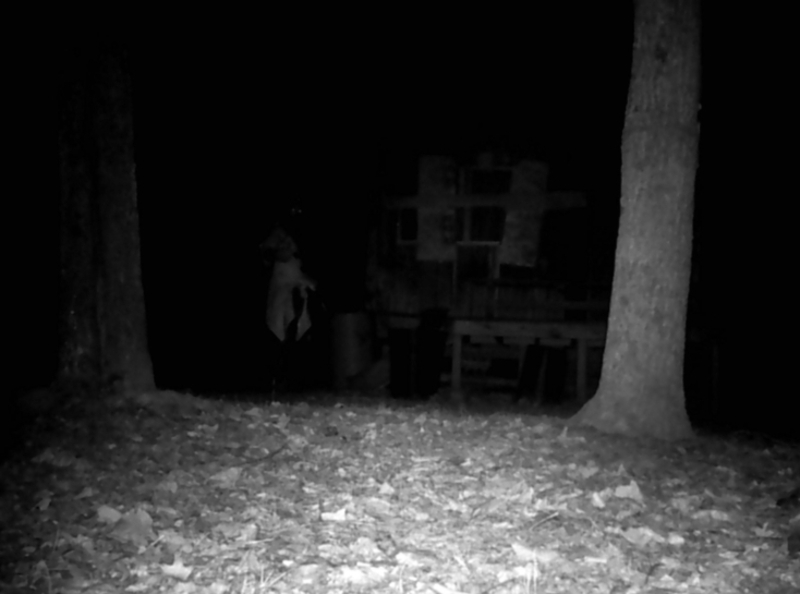
By the looks of it, the white object could be a coyote or a small antelope. Whatever it is, is clearly holding onto the smaller animal and the figure in question is completely black. Even for a bear, this would be pretty big and might allude to the suspicions about Bigfoot.
Moose-ing Around
Aren't moose such interesting creatures to study and observe? With their distinctive antlers that can span over 6 feet across and their incredible size, moose are the largest species of the deer family and one of the largest land mammals in North America. What a treat to capture them on camera.
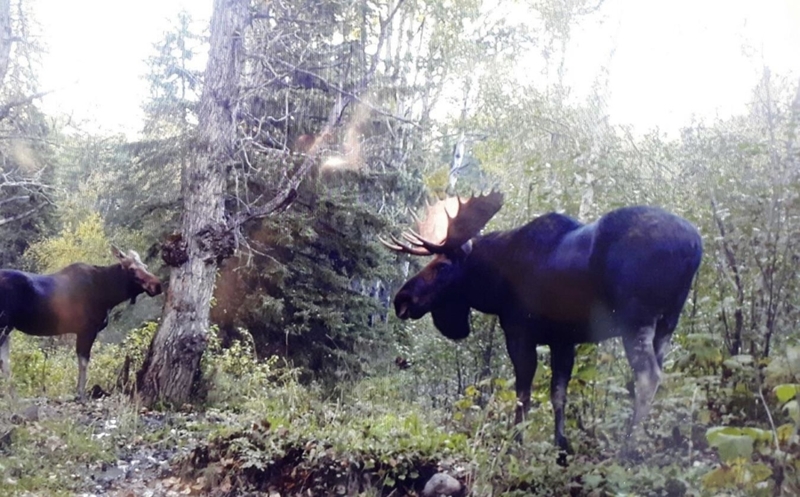
What's even better is that we get to see them in their natural habitat. They probably have no idea that there's a camera taking photos of them, they're just roaming through the woods. They're usually solitary animals so seeing them together like this could mean that it could be mating season.
Glowing Eyed Buck
This doe looks exactly like a deer in headlights. But here she's been photographed all on her own in the middle of a wooded area. While deer can feed any time of the day, they are also considered dinner for predators so they sometimes prefer feeding at night so they can be alert and ready in case of danger.

It could be that the snap of this camera startled this doe while she was eating, or maybe it was a flash that drew her attention and made her look. Fortunately, it's just a trail cam and not a predator about to pounce. Otherwise, she'd probably be running away to safety.
Deer Up Close
This adorable and equally hilarious close-up photo was taken of a deer right as he was nearing this trail cam. We can tell that this must be a young deer. Could it be the sound of the camera or the flash from the lens that frightened him, causing this look of shock on his face?
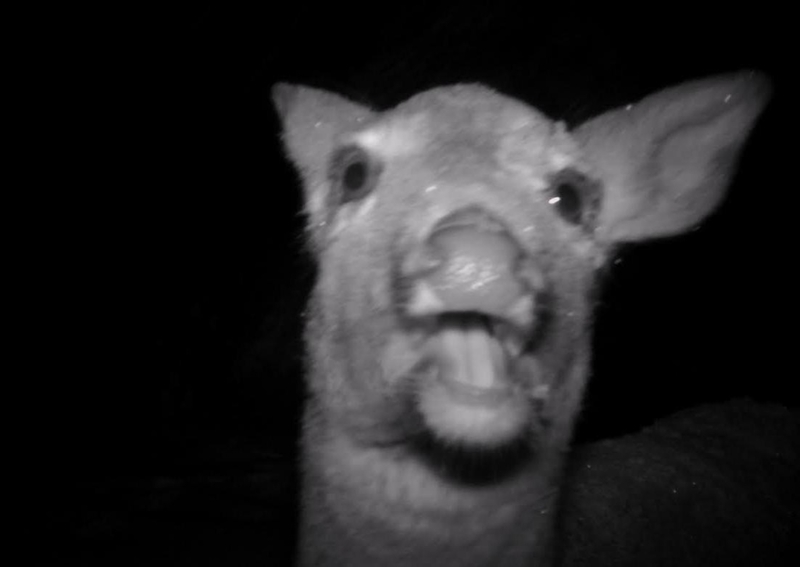
Or maybe they put food on the trail cam to make it come close? It could also look like he is in the middle of chewing. Poor fella was probably not expecting a photo while he was enjoying his meal. We know we'd be pretty ticked off if someone took a photo of us while we were eating.
Bear Selfie
Bears are known for being curious by nature because they're constantly exploring their environment and snooping around. When it comes to their curious nature, it's actually a natural instinct that helps bears survive in the wild. Take this nosey bear for example, he can't help but investigate this trail camera.

What's more, bears have an incredibly keen sense of smell, which is 100 times greater than ours, which means they pick up scents and smells that we wouldn't even notice. Their curiosity can lead them to investigate new smells and sources of food, even if it means taking risks or exploring unfamiliar territory.
Hey Look, It's a Tapir!
Wow! That's one creepy-looking Tapir. The flash made his eyes bright yellow which gives him this incredibly eerie stare. Besides his beady eyes, Tapirs are pretty weird-looking creatures. They have a distinctive snout that resembles a short trunk, which they use to grab vegetation and bring it to their mouths.

Tapirs are found in several regions throughout the world, including Central and South America, Southeast Asia, and parts of the Philippines. All species of tapirs are primarily forest dwellers and require access to water sources such as rivers, streams, or ponds. They typically inhabit areas with dense vegetation, including rainforests, cloud forests, and swamps.
Wowee
We never thought we'd see this on a trail cam! It would seem that this deer has a hydrocele, which is a type of swelling in the scrotum, the pouch of skin that holds the testicles. This swelling happens when fluid collects in the thin sac that surrounds the testicles.

It could be that this poor guy suffered some kind of injury to the area, maybe he suffered a kick to the groin which has now caused it to become swollen. While they're not known to be harmful, they can definitely be uncomfortable and sadly, we doubt this deer has a vet on speed dial.
Wild Whitetail Footage
Wild Whitetails are known for being very adaptable and for their ability to thrive in a variety of different habitats, from forests and grasslands to suburban and urban areas. These animals certainly aren't rare, but it is rare to see them running like this in the middle of the woods.
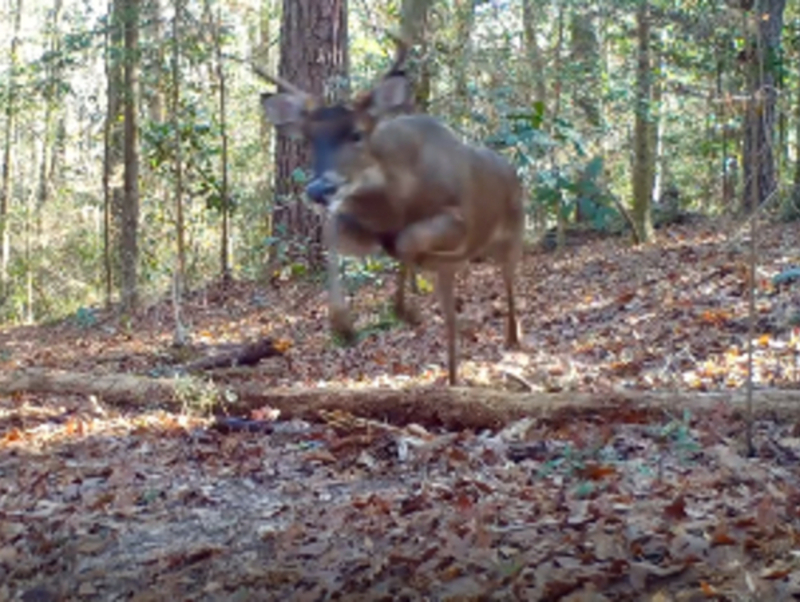
Maybe we're just being a little sentimental because we've seen "Bambi" a few too many times when we were younger, but we really enjoy seeing deer unencumbered by urban sprawl and human development. There really is nothing like watching wild animals roam free in the woods, just as nature intended.
Polka Dot Moose
We have never seen a moose with fur like that! What a special coat he has, we've never seen anything like it. Moose are not typically known for having a polka-dot coat. However, this looks like a young moose. Moose calves have a unique coloration when they are born, with white spots on a reddish-brown coat.

This helps them to blend in with their surroundings and avoid detection by predators. Occasionally, moose may have white or lighter-colored patches on their coats due to a genetic condition called piebaldism. This condition results in patches of unpigmented skin and hair, which can give the appearance of spots or polka dots.
White Snow
This snowy white deer is so beautiful! The only time he blends in must be in winter when everything is covered in snow. We didn't know that deer can be white or nearly all white. This coloration is due to a genetic condition known as leucism, which causes a loss of pigmentation in the deer's hair and skin.

Leucistic deer can appear almost completely white or have patches of white on their coat, but their eyes, nose, and hooves remain the typical dark coloration of their species. Given that white deer can't disguise themselves as well in nature, they become easy prey for hunters and other predators such as coyotes. It would be impossible for such a herd to survive in the wild.
Act Natural
Have you ever seen a deer walking on its hind legs? While it may seem like an unlikely scenario, we now have proof that deer can practice this peculiar behavior. While it is unclear why this deer decided to walk on two legs, it could be that this is a learned behavior.

The sight of a deer walking on its hind legs is certainly a curious one and has captured the attention of many people around the world. It is not completely unheard of that animals learn new behaviors to better adapt to their surroundings and it certainly reminds us of how surprising nature can be.
When It's Raining
We've all wondered what animals get up to when it rains outside. No sun? No stress! Storms won’t dampen the spirits of this black bear. Even when it might be too rainy to hunt, there are still plenty of opportunities to fish. Whoever said fishing in the rain wouldn't be fun?
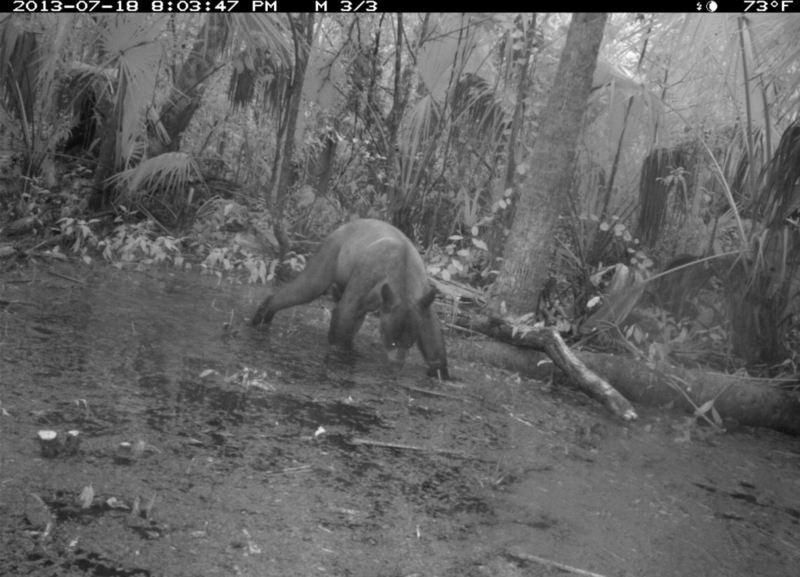
Bears live for the thrill of wrestling the behemoth sea monster on the other side of the lure. So when it comes to fishing, it would appear that it is a no-brainer any time of year. Come rain or shine, bears are always ready for a quick dip. Especially if it means they can get a tasty reward.
Coyote Style
When you've got a trail cam set up in the middle of nowhere, you're bound to find some interesting footage! However, you probably weren't expecting it to be this raunchy. It’s not enough that these two coyotes got caught in the middle of their intimate encounter, but they’re also both staring directly at the camera.
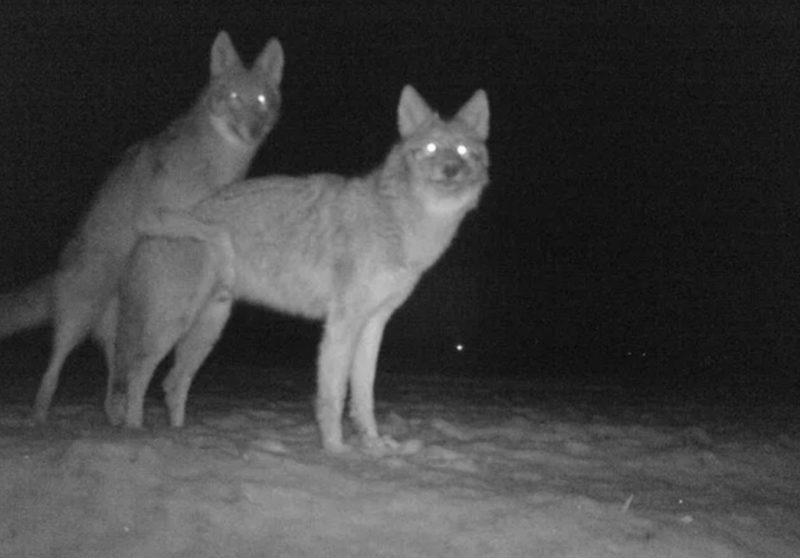
Nature can get pretty explicit, we just weren't expecting it to get this explicit! The flash of the lens or the sound of the camera must have caught their attention, making them look right at the camera, almost as if they are posing for it. Give the dogs some privacy!
Monkeying Around
The police department in Gardner, Kansas had locals reporting a mountain lion roaming Celebration Park in the city. After setting up cameras on a trail because of their concerns, they were "Glad to report that over the time they were up we did not see a mountain lion," as their Facebook post stated.

"We were however surprised by some of the images that the cameras did take." It would appear a handful of residents found the cameras and decided to have some fun with them. If these black-and-white horror gorillas freak you out, you're not alone, these photos are pretty strange.
Oh Deer
What would you do if you were loading up your gear from your hunting trip and you came back to the truck to find this? This buck is obviously feeling bold after making it out of the forest alive that day. Maybe he was looking to hitch a ride to the other side of the forest?
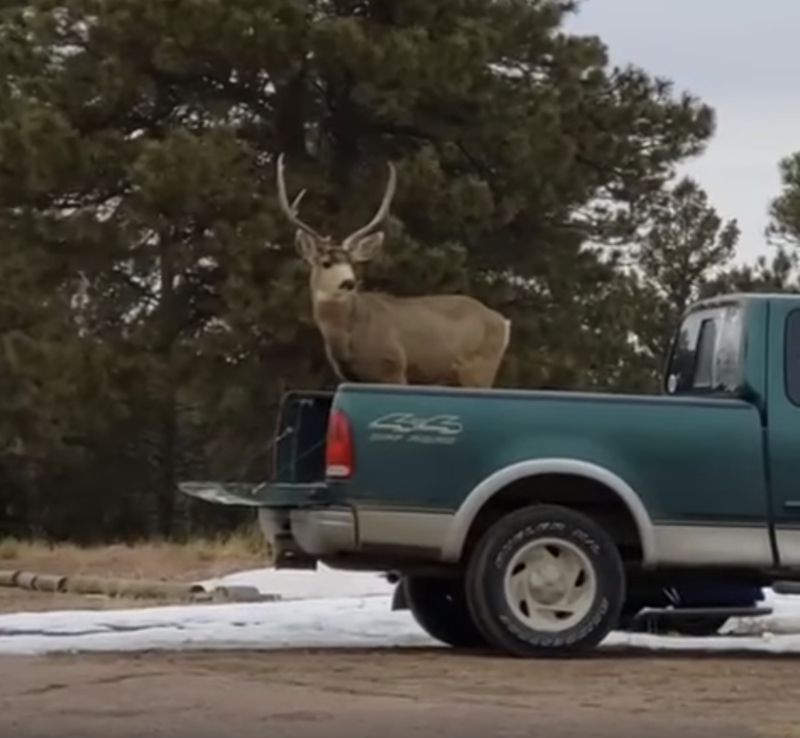
As we've already established, deer are curious creatures and if they don't feel threatened they'll readily explore a new area. Even if it is the back of someone's truck. But a beautiful deer like that better be careful, the driver might be tempted to take him home and make a meal out of him.
Masks Off
This trail cam caught something that any homeowner would be terrified to see. Just imagine checking your footage and seeing this creepy…whatever it is. What on earth is this person doing? He probably felt like it would be fun to prank his neighbor and wear a dog mask while posing in front of the trail cam.
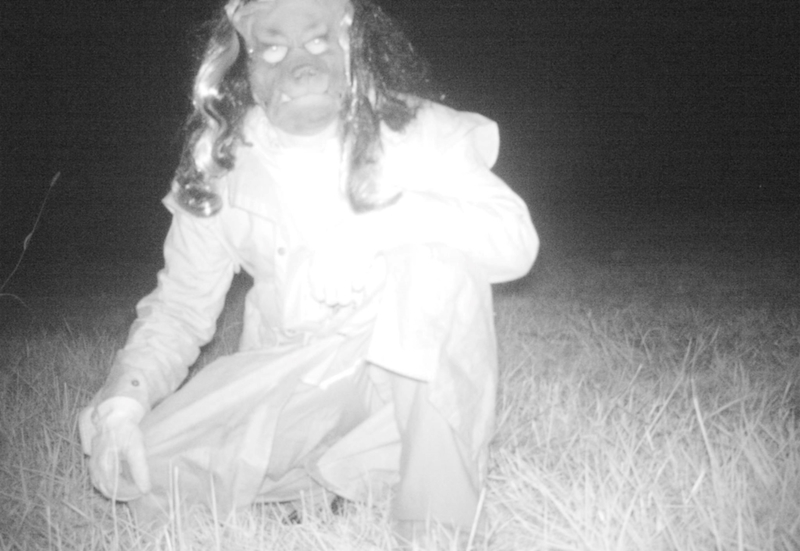
We don't know about you, but we would be super freaked out if we saw footage from our trail cam with someone in this mask roaming around our backyard. Note to self.... stay the hell out of the backyard late at night! You never who or what could be roaming around.
A Little Elusive
When we first saw this photo, we were sure that these are a Black Bear and a Grizzly. They have to be, right?! Grizzly bears are larger and more aggressive than black bears, and they have been known to attack black bears in the wild. But it seems like these two are quite friendly towards each other.
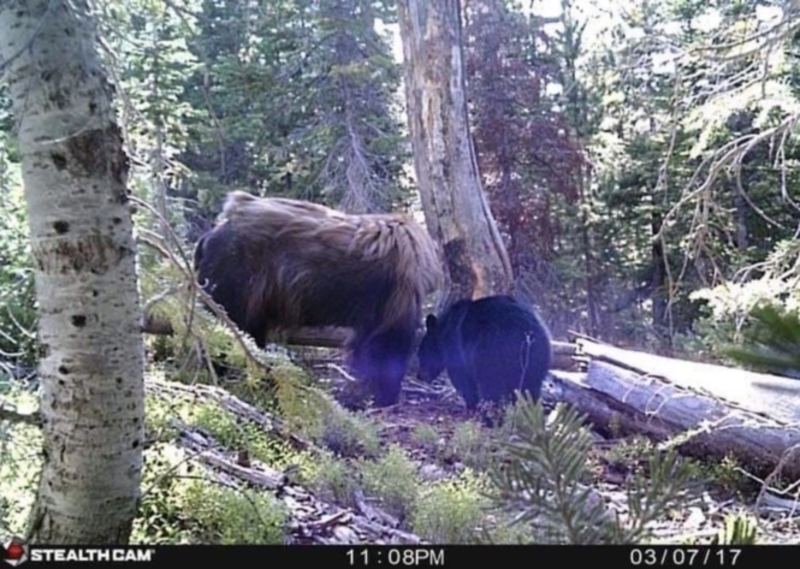
It could be that our eyes are tricking us cause that bear almost doesn't look like a Grizzly. Its coat looks a little too shaggy, so we were thinking it could be a Scottish Highlands cow, but that's not realistic in the woods of America, so it must be a Bison.
Pronking
Stags are known as stoic creatures, silently roaming their territory while showcasing all the dignity that comes with the job of being a majestic deer. However, it looks like they also enjoy letting loose every once in a while, as proven by this photo of this deer hopping in front of this trail cam.
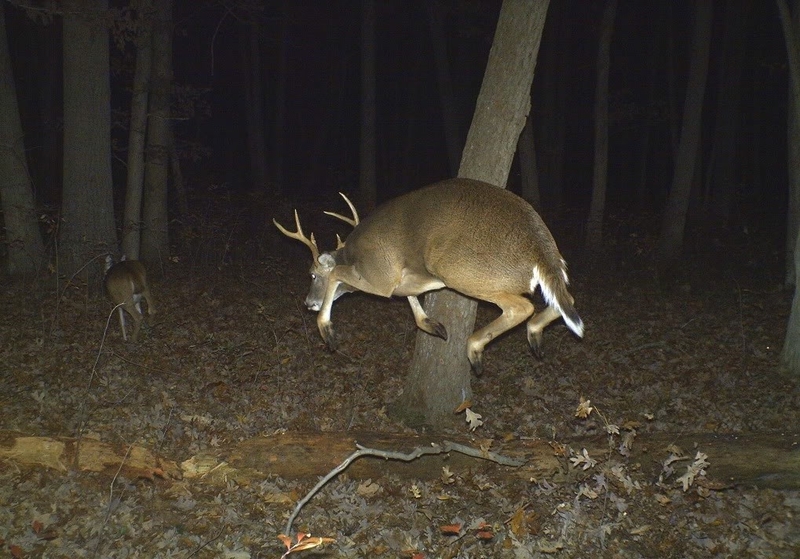
The hopping gait that this deer is using is called "stotting" or "pronking", and as we can see he's jumping with all four legs off the ground at the same time. He's probably in a rush and trying to catch up to his friend. Or it could be that he's just in a really good mood and feels like pronking.
It's Business Time
Trail cam footage of a fox can be an interesting and educational glimpse into the life of this elusive and often nocturnal animal. But sometimes, it's just footage of an unsuspecting fox doing its business in the woods. Fortunately, the sound of the camera didn't startle this fox, otherwise, he would have run away.

While still mildly interesting, it's not exactly what we expect to see when scrolling through footage. Some might even say that this is the fox's natural display of dominance in order to establish its territory. By doing so, foxes can reduce competition in their area while also maintaining scarce resources.
Creepy Forest Footage
Several people have tried to debunk this trail cam photo, saying that it was either some type of prop, or CGI, but they haven’t quite been able to accurately define what this is. So, what exactly are we looking at? Is it some kind of strange creature we're not familiar with?

We could be wrong but it almost looks like it could be some type of foliage falling from the nearby tree. If it was just a leaf or an acorn or something, then it must be pretty close to the camera to make it look so big. That's our best guess. What do you think it could be?
Mama Bear With Her Cubs
Sometimes, a mama bear decides to take a leisurely stroll through the forest with her two cubs would follow closely behind her. On this particular night, Mama Bear stumbled upon a beehive in the middle of the forest. Honey is always a hit with bears, just ask Winnie the Pooh.

Not only are these captures great to see but they also provide biologists and researchers with important data when it comes to animal populations in certain areas. This trail cam is situated in Northern Florida and the data can help protect and conserve different species and help keep the ecosystem healthy.
Symbiosis
Here’s an example of symbiosis we never knew existed. For those of you who don't know what symbiosis is, it's when two different species of animals form a relationship that can be mutually beneficial for both. In this example, a possum gets an easy snack and the deer gets a free cleaning.

The most well-known symbiotic relationships are between birds that clean out the parasites from crocodiles' textured skin and fish that eat parasites from shark's underbelly. This, however, is something we haven't seen before. Isn't this neat? We can't help but wonder if deer actively seek out possums for this.
What Is That?
This is a case of someone’s trail cam unintentionally picking up something that looks like it’s come straight out of a nightmare. It almost looks like it could be Bigfoot... But he doesn't exist, right? There have been many reported sightings of a large, ape-like creature in various forests and woodland areas.

But, despite many years of investigation and search efforts, no conclusive evidence has been found to prove the existence of Bigfoot. However, some people still believe and insist that Bigfoot is a real animal that has somehow managed to evade detection, and most scientists and researchers are skeptical of its existence.
A Pair of Grooming Panthers
According to the Biologists working at the Florida Fish and Wildlife Conservation Commission, these two panthers grooming each other are siblings who were raised at the White Oak Conservation Center in Yulee since they were 5 months old. The FWC panther team leader reported that these two panthers were fit and healthy to be released back into the wild.
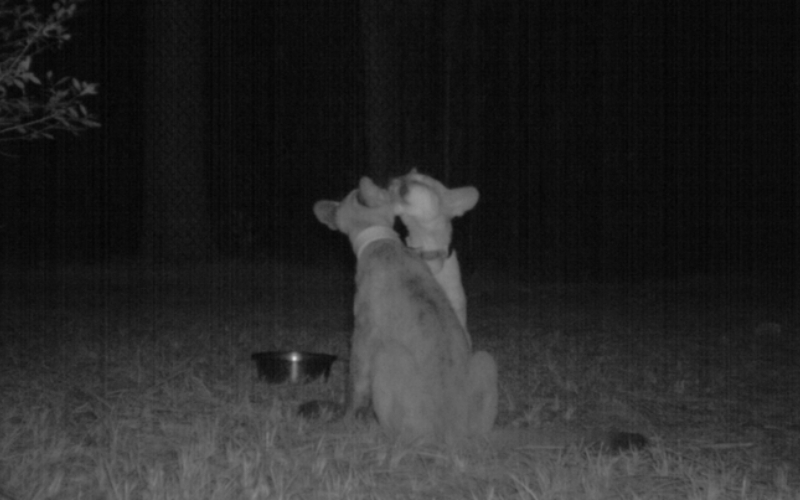
As with any wildlife rescue, the ultimate goal is to be able to release the animal back into the wild to aid in the recovery of this endangered species. It's estimated that 100 to 160 adult panthers remain in South Florida. We might not all live in Florida, but it's still great to hear about success stories like this one.
Coyote
Finding a coyote in your backyard can be a thrilling and sometimes unnerving experience. These elusive creatures are known for being incredibly intelligent and adaptable to new environments. It's not that rare to see them in suburban areas, but if you do happen to spot a coyote in your backyard, it is important to keep your distance.
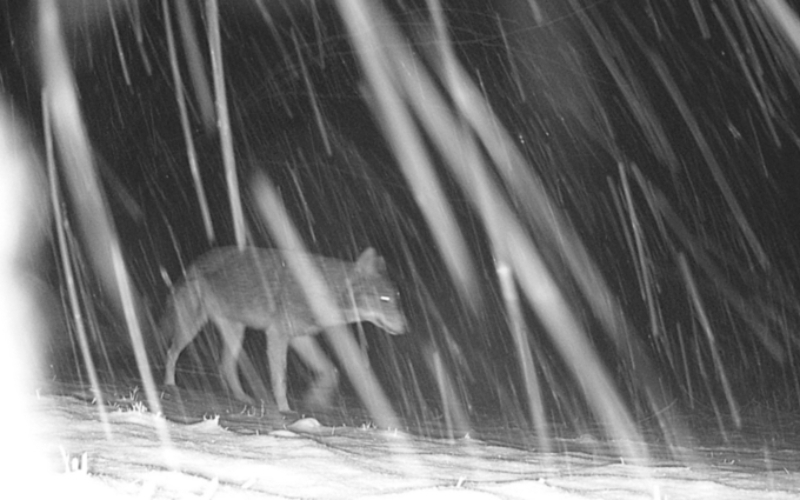
These animals are wild and should not be approached. If they feel threatened in any way, they could attack. So remember to treat coyotes, as with any wild animal, with caution. The last thing you want is to get bitten by one. You can always contact your local wildlife agency if you see one and need help.
Racoon vs Deer
Both raccoons and deer are wild animals found in many regions of the world. While they may occasionally cross paths in their natural habitats, they are not typically known to interact with each other in a way that could be considered a competition or a fight. But here we see them carefully sniffing and interacting.

In terms of physical size and strength, it's clear that these three deer can easily overpower this raccoon. They are much larger and stronger, as a full-grown deer can weigh up to several hundred pounds. But we doubt that these creatures are about to fight, they're probably just curious about each other.
Santa?
After all of the reindeer caught on camera, you have to start to wonder where Santa Claus had gotten off to. Well, this might finally be proof that he exists, thanks to this random camera set up in someone’s yard in Canada. According to legend, Santa Claus is said to live at the North Pole, which isn't too far from Canada.
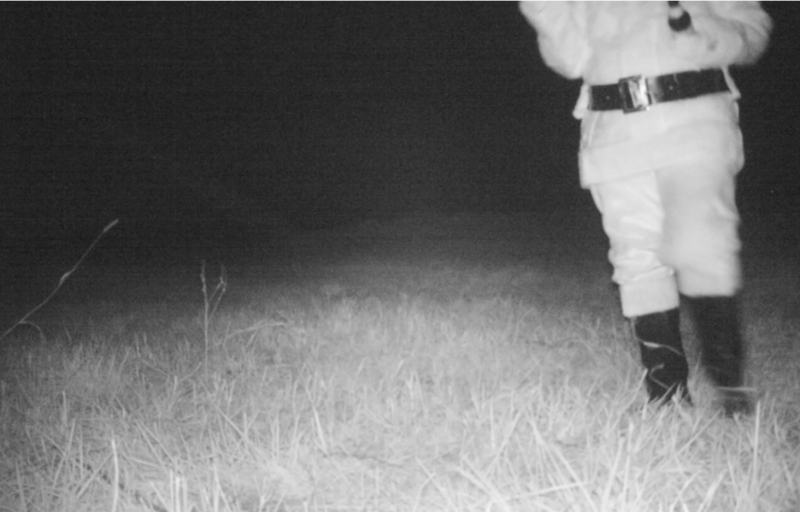
Santa Claus is said to spend most of his time preparing for Christmas Eve and delivering gifts to children around the world but maybe he took a vacation during the summertime. Given the demands of delivering presents to children around the world, it's unlikely that Santa would have much time for a vacation during the busy Christmas season!
Raccoons, Assemble!
If you’ve ever come face-to-face with a hungry raccoon, you know that it pretty much will stop at nothing to achieve its goal to eat. In this case, the goal was to reach the bird feeder full of delicious seeds. Like many animals, raccoons can become feisty when they are hungry.

But despite their hunger, these raccoons are working together in the hopes of reaching some tasty treats. Let’s just hope they all got equal shares. After all, they’re each working pretty hard to reach the munchies. Just don't get in their way, otherwise, they might think you're after their food.
Striped Skunks
Striped skunks are remarkable creatures, not only are they adorable but they're also known for their unusual defense mechanism, which involves spraying an incredibly strong noxious liquid from the base of their tail. This deterrent allows them to thrive in their environments as it's an incredibly powerful defense against all threats and predators.

We don't get to see them as often as other wildlife species due to them mostly being nocturnal animals, plus they're known for their strong aversion to humans. Besides all that, skunks are pretty cute and while they may not be considered cute by everyone, their unique characteristics can make them appealing to many people.
Moo-vie Star
This cow looks like it’s doing the over-the-shoulder glance that celebrities like to give the cameras when they’re on the red carpet. She was definitely ready for her close-up when she got caught on this yard cam. Or maybe she’s looking over her shoulder because the sound of the camera startled her?
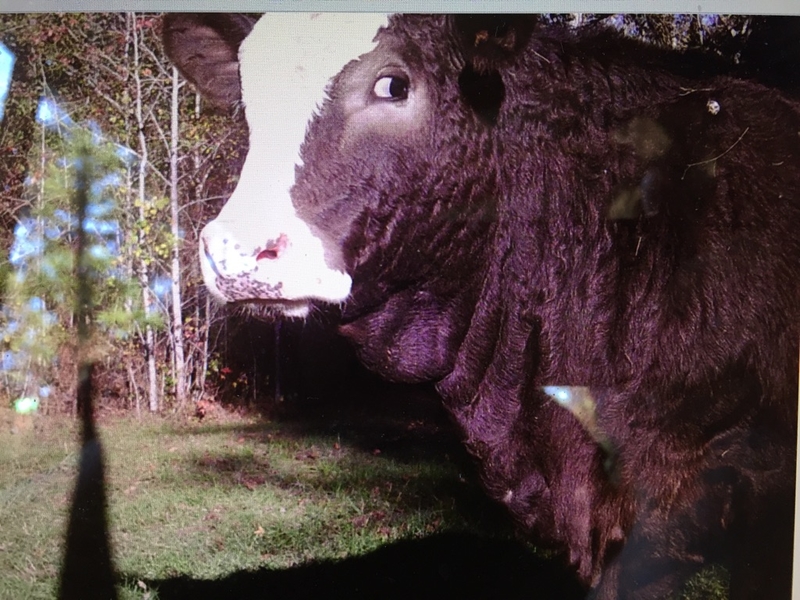
Cows can be easily startled or frightened, especially if they are not accustomed to human presence or sudden loud noises. Cows are usually docile and peaceful animals if they are treated with care and respect. However, they are large animals and can be dangerous if they feel threatened or cornered.
Marten
This marten thought he could get his hands on some food from this bird feeder. Martens are part of the weasel family, which means they're agile and skilled climbers. As we can see, this Marten can easily scale this tree and reach the bird feeder but he probably won't be interested in the food as they are carnivorous creatures.

The footage of this Marten was taken in by a trail cam in Italy, which means this specific animal is considered an endangered species as their numbers are really low right now. However, other species of Marten, such as the American marten, have much healthier populations and are at risk or considered endangered.
Pupper
We expect to find many wild animals on trail cams, but it's quite unusual to find a puppy meandering through the woods. We wonder what happened here. Is this a puppy from a litter that lives in the woods or is someone taking it for a walk in their forest of a backyard?

Just the fact that this little guy is exploring means it must feel safe enough to do so, otherwise he would be waiting with the rest of the litter for his mother. We do hope he's ok, it is important to provide proper care and attention to puppies to ensure they are healthy and safe.
Coyote Catch
This scruffy-looking coyote happened to pass by this trail cam with bird remains in his mouth. While coyotes mostly like to eat smaller mammals such as rodents, rabbits, and hares, they are still opportunistic predators and if they can find other prey, they will try to catch and eat birds, reptiles, and even insects.
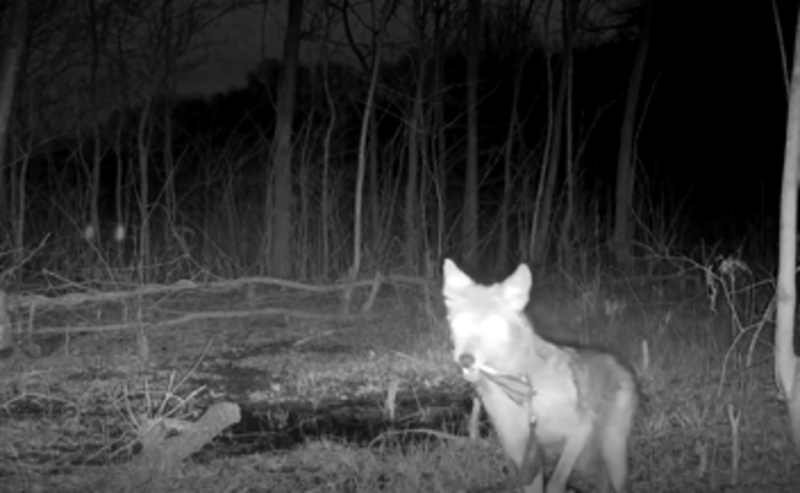
Coyotes are feisty and determined hunters and can pursue birds on the ground or in the air, depending on the species and their hunting techniques. Coyotes have been observed by biologists and researchers as they catch a variety of bird species, including game birds, waterfowl, and songbirds.
This Wolf Might Have Issues
The shot of this wolf with his legs so weirdly positioned sure looks eerie. We're not sure, but it could be that this photo was taken as the wolf was turning, which gave his legs this strange position. However, like all living creatures, wolves can potentially have genetic issues that can impact their health and well-being.
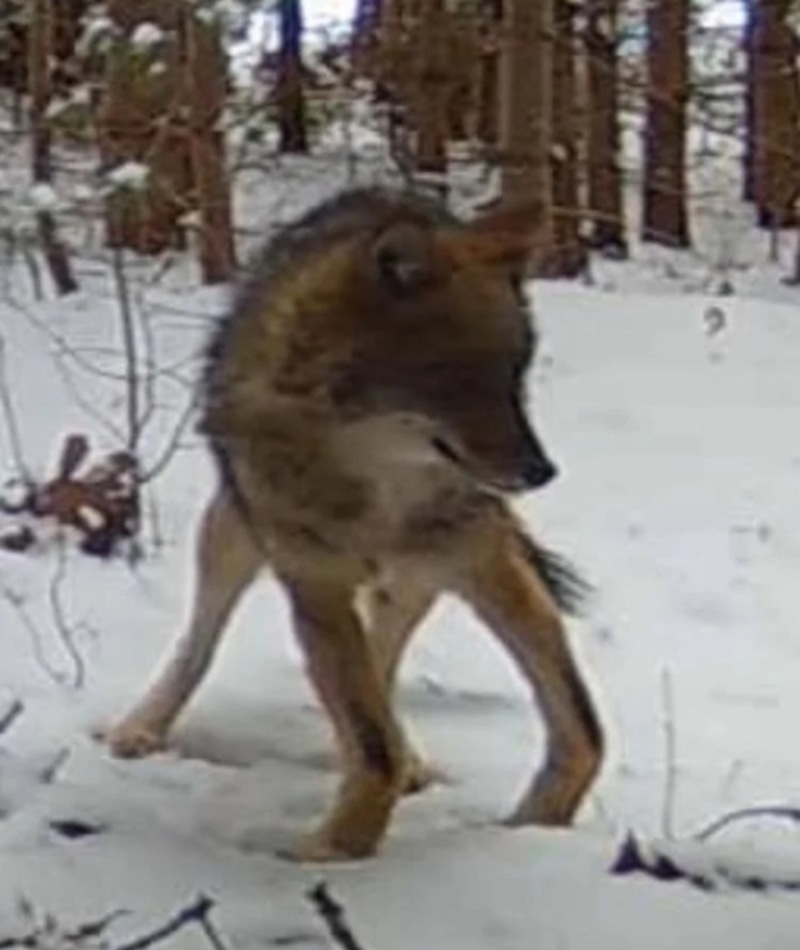
It could be that this wolf has hip dysplasia, a condition in which the hip joint doesn't develop properly, causing pain and mobility problems. This condition is thought to have a genetic component and is more common in certain breeds of domestic dogs, but it can also occur in wolves.
Hello There
If that beak doesn’t look like it could tear smaller animals into kibbles and bits, we don’t know what does. Of course, it could also be that the angle the lens has on this bird makes it appear more menacing than he actually is. Birds of prey are awesome, but they can also be dangerous.

Vultures have often been misunderstood since they are scavenging birds that feed on carrion. But actually, vultures play an important role in many ecosystems by helping to clean up and dispose of dead animals, which can help prevent the spread of disease. It's also worth noting that some species of vultures are endangered.
Wild Turkey Visit
Turkeys are traditionally considered the center of the Thanksgiving feast, so is it any wonder that when we see these wild turkeys, we think of Thanksgiving? Clearly, we're not the expert when it comes to observing turkeys in the wild, so we're pretty impressed with how big these birds look.
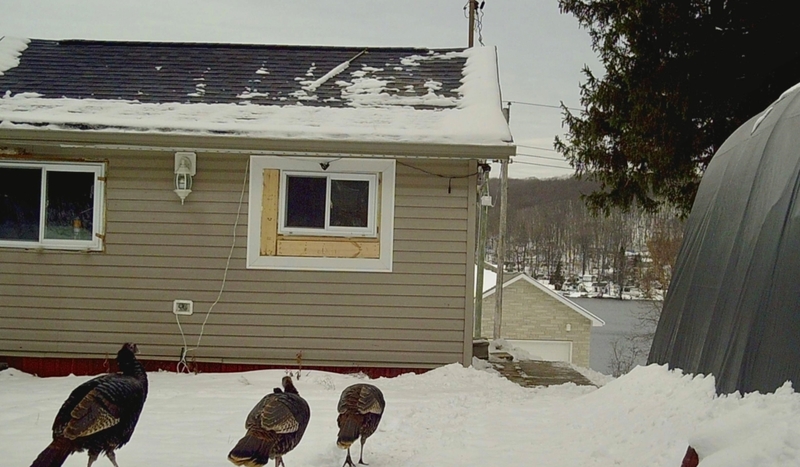
After a bit of research, we discovered that wild turkeys used to be an endangered species in the United States, but thankfully, conservation efforts over the past century have helped to bring their populations back. Nowadays, turkeys can be found all over the country, with many people enjoying watching them in the wild.
Surprised Deer
Have you ever wondered what deer are up to when you’re in your house? Trail cameras are awesome tools for giving a sneak peek into their lives and whereabouts during the darkest time of the night while you are sound asleep at home. Well, here we have one surprised deer who was not expecting to have his picture taken.

Unlike some other mammals that may make their way into our neighborhoods, deer are one of those animals that most people recognize but know very little about. But there is always more to learn. Did you know that male deer grow new antlers every spring? Well, they do, and it’s amazing to consider how quickly they grow.
Be Cool and Blend In
Ducks and flamingoes are not typically found in the same environment, due to the fact that they have very different needs and habits, but here we see two ducks blending in with the flamboyance of flamingoes. And yes, flamboyance is the collective noun for a group of flamingoes! Isn't that neat?
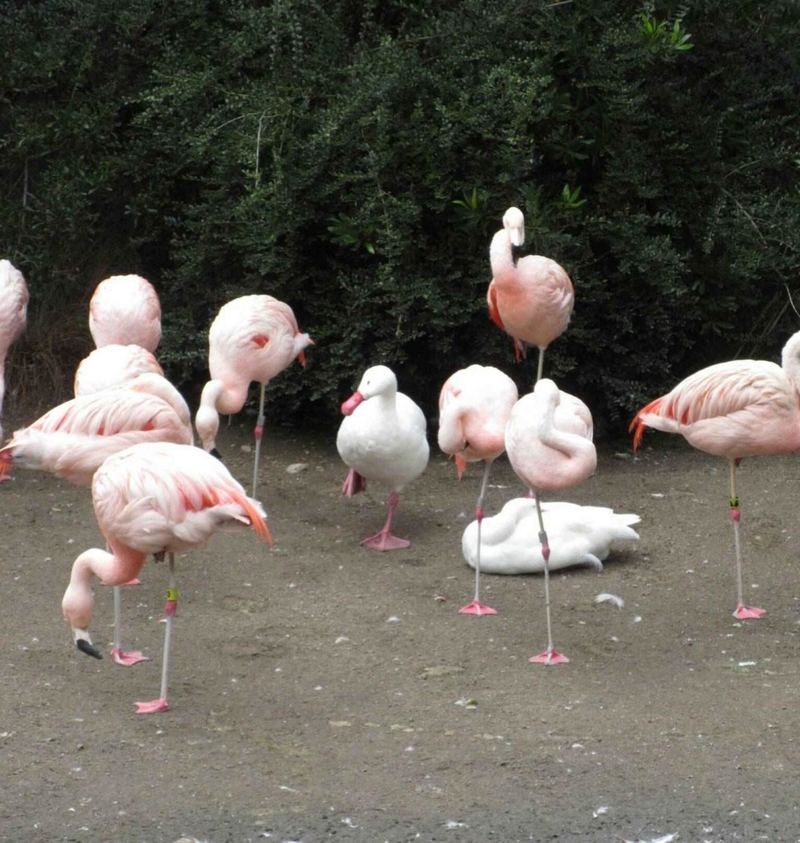
We have absolutely no idea who it was that came up with all these collective nouns back in the day, but whoever it was, they were brilliant at their job. Flamingoes really do look like a flamboyant bunch, standing on one leg with their dazzlingly pink feathers, and their slender necks.
The Bobcat Cam
This bobcat was out for a stroll one day when he decided to come and check out this shiny thing he hadn’t seen before. Then the camera took a snap of him as he was getting closer. He soon found out that this little thing also flickers and snaps, quite unlike any animal he knows.
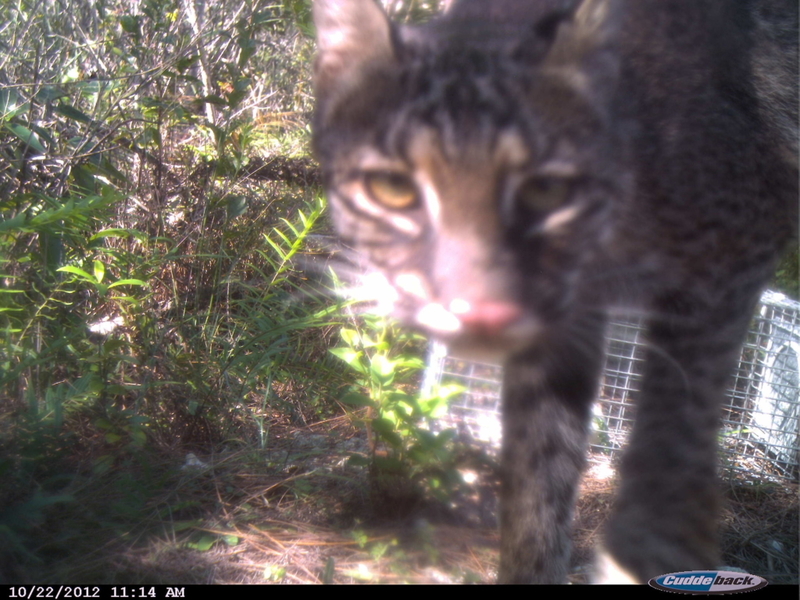
While some animals may be curious about cameras and investigate them, others may be wary or even frightened by them and a fair few might even feel threatened by them and attack. This bobcat was definitely curious. He didn't mind getting up close and personal with this strange object at all.
Good Kitty
As cute as cats may be – even large cats – this is not something you want to see on your security footage from outside of your home, especially if you’ve got cats (or dogs) of your own. We all know that animals, whether wild or domesticated, can get territorial.
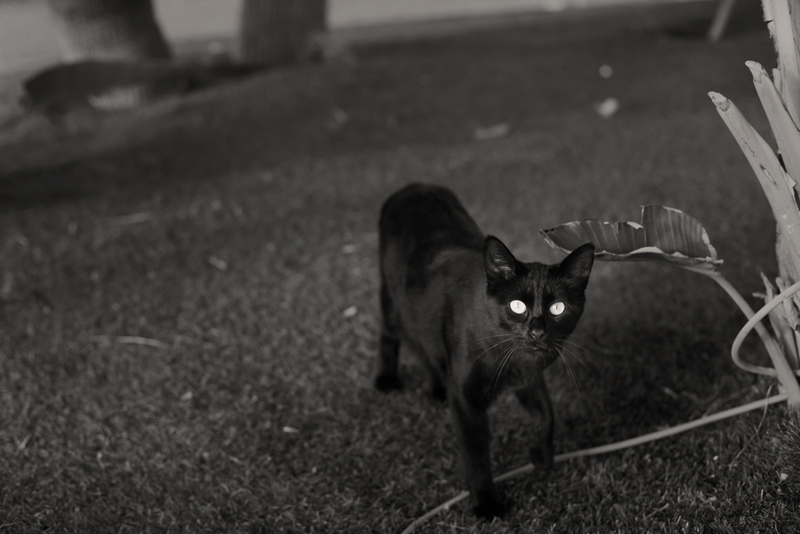
The last thing you want to hear late at night is a cat or dog fight and have to worry about your furry friends. Fortunately, this is just another housecat. It could be worse, after all, you wouldn't want a cougar or bobcat in your yard. That cat (or dog) fight could get ugly!
Heavy Headed
Wow, just look at this big boy and his massive antlers. Judging by the size of those, this male deer must be very healthy. In North America, the average weight of white-tailed deer antlers is around 6-8 pounds, with some male deer able to grow antlers that weigh up to 15 pounds.
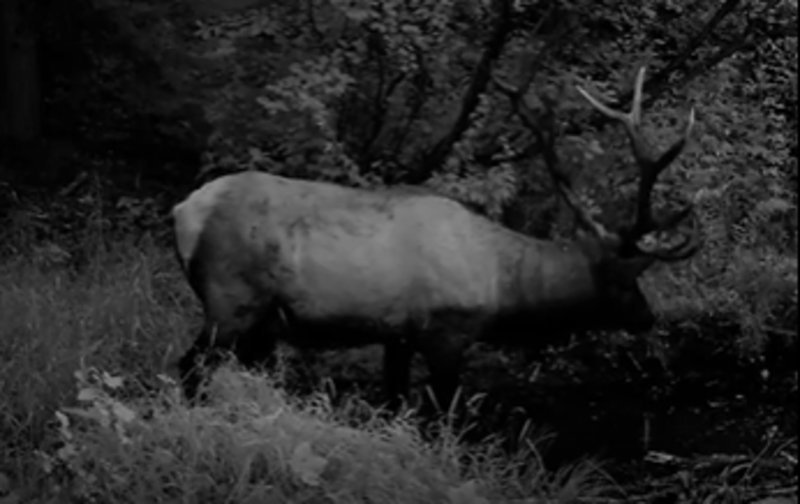
Now, we're not sure how much his antlers weigh, but we'd hazard a guess that they're on the heavier side. As you can probably tell, this photo was taken in infrared mode, and the black-and-white color just makes the footage of this deer and his big antlers look that much cooler.
I Just Can’t Bear It
Does anyone else just want to go pat this bear on the back and ask him how he’s doing? It looks as though he’s had a rough day and needs to talk about it, and maybe even get a bear hug. When seeing a bear like this one all on his own, we can't help but wonder about him.
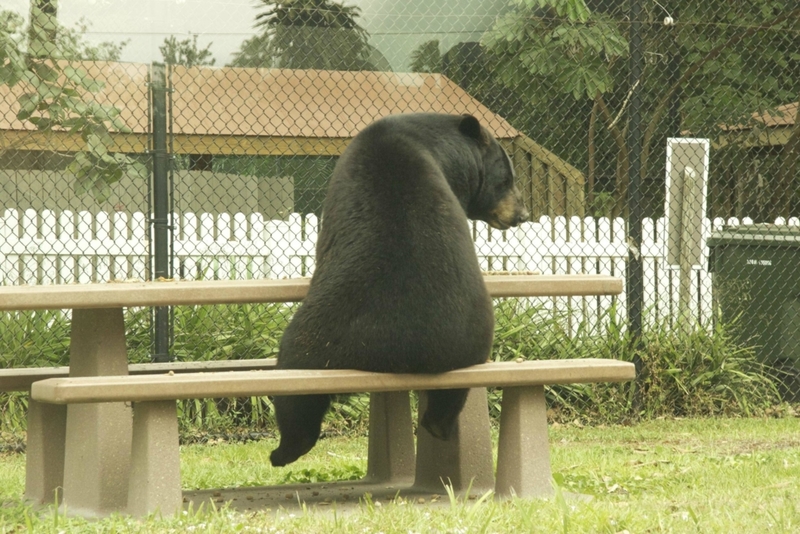
What is he thinking? Is he waiting for some friends or just waiting for some lunch? We don't exactly have the expertise to know what's going on inside his head. We can only imagine that he must be hungry and perhaps this picnic spot was the last place he found some food.
A Pair of Coyotes
Here we see a pair of coyotes frolicking through this field, their coats are different colors so it's highly likely that they're unrelated. But as we know, coyotes are social animals and while coyotes are known to form strong social bonds with their own family or pack, they can also form bonds with coyotes outside of their immediate family.

We don't often see a coyote with a coat this dark, as the color of a coyote's coat changes throughout the year, appearing thicker and darker in the winter months and lighter and thinner in the summer. We wonder how this one got such a dark coat while the other one is much lighter.
Ninja Rodent
Squirrels are known for their ability to climb trees and other structures, jump long distances, and navigate obstacles with ease. They are also known for their lightning-fast reflexes and ability to quickly escape danger, but despite all that, we've never seen or even heard of a knife-wielding squirrel taking on a snake!
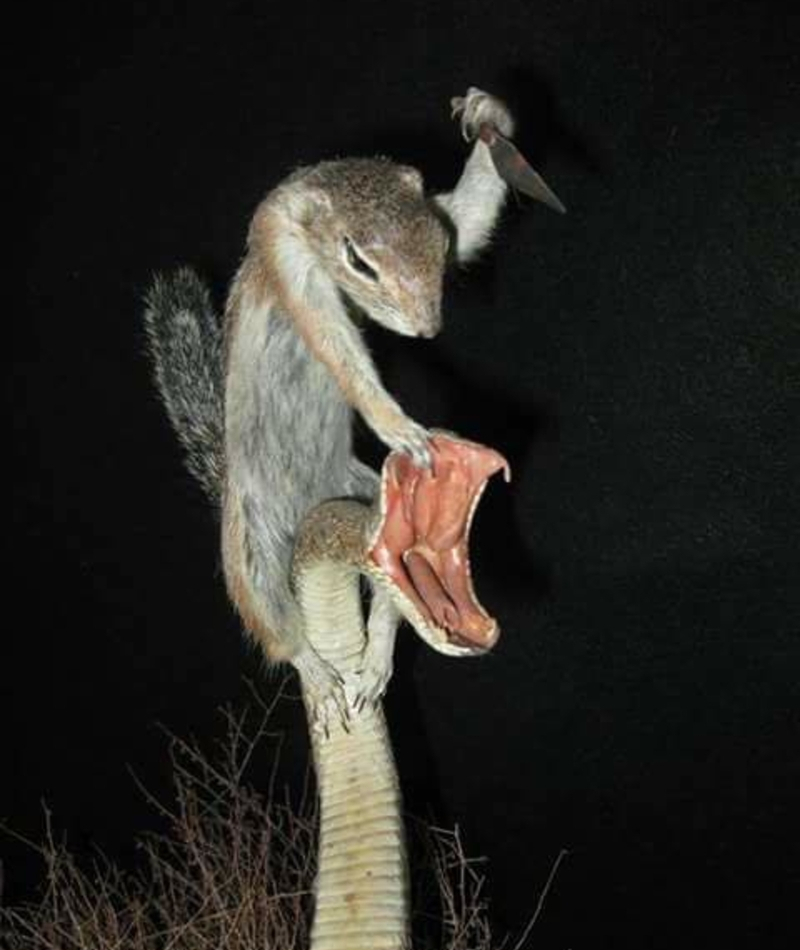
This is obviously a prank and some taxidermist thought it would be funny to create this scene with a squirrel and snake and set it up right in front of a trail cam. Well, now you can finally stop searching the web to find the strangest, most outrageous trail cam photo on Earth.
Baby Bear
This charming little bear cub got caught on trail cam sitting in the middle of this field at the edge of this forest. Perhaps he's spotted a butterfly or some other insect that caught his eye because he looks a little absorbed in that patch of grass. He looks a little young to fend for himself so we wonder where his mother is.
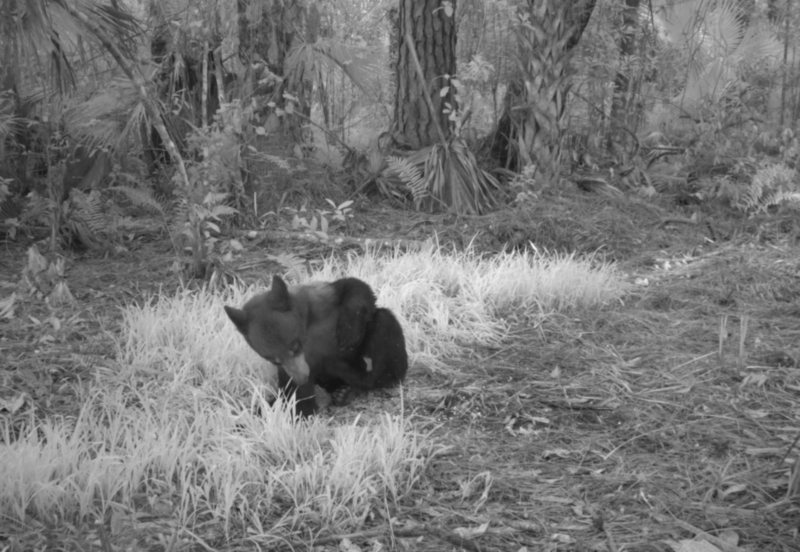
Typically bears leave their mothers at around one and a half to two and a half years of age. It takes this long for bears to learn important survival skills, such as hunting, foraging, and how they can best avoid danger. Mother bears do sometimes leave their cubs for longer periods of time, particularly as the cubs become more independent.
Water Hole
A group of javelinas shares a drink from the bird bath in someone's backyard. For those who've never heard of javelinas — they are medium-sized pig-like mammals that are found in the southwestern United States, Mexico, and Central and South America. Typically, they are about 3 feet long and weigh between 30 to 60 pounds.
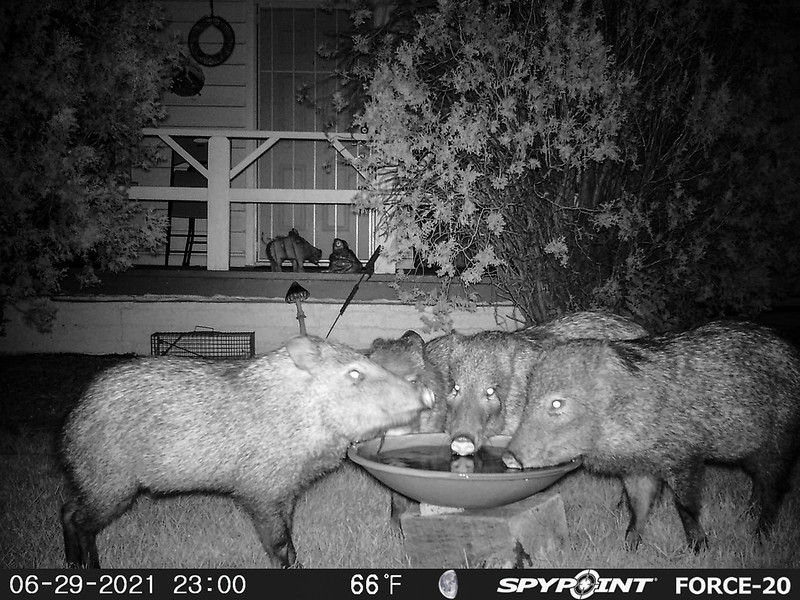
Javelinas are part of the peccary family and while they look a lot like wild pigs with many people mistaking them for boars, they are actually a distinct species. This group was so delighted to find a source of water and they didn't seem to mind that it was meant to be a bird bath.
Baby Antlers
Just look at this moose's tiny antlers. Is he an adolescent or are they just starting to grow in for the year? Apparently, they start growing in the spring or early summer, typically in May or June, and are triggered by the lengthening daylight hours and rising hormone levels in males.

Moose antlers grow rapidly during the summer months, with males able to grow up to an inch of antlers per day. Moose typically shed their antlers in the winter, typically in November or December. By the looks of it, this little fella's antlers make him about one or two years old.
Could This Be an Alien Spaceship?
Pop culture has given us plenty of ideas of what aliens might look like. From the mysterious Greys of "The X-Files," to the flashlight-fingered E.T., and French Stewart in "3rd Rock from the Sun." Were all these examples made up of science fiction stories or were they based on actual evidence?

We don't know, but this photo taken by a trail cam looks eerily like something we'd see in "The X-Files." Or is it that "The X-Files" based their show on footage found by NASA scientists and experts? It looks like there is some strange being in the background. Maybe it's the alien that this spaceship belongs to.
Bear Taking a Bath
Bears are known to be good swimmers, and they do occasionally take a dip in the water to cool off, catch fish or clean themselves. However, bears do not typically take baths in the way that humans do. They groom themselves by licking their fur to remove dirt and debris.

How cute is this? If you've never seen a bear bathing, this footage from this trail cam is as good a look as you'll get. Cooling off like this and soaking in water helps bears keep their fur clean, healthy, and insulated, which is also important for their survival in the wild.
Wile E. Coyotes
Coyotes are typically found in the desert, but did you know they're highly adaptable animals and can even be found in colder habitats like Alaska and Canada? In general, coyotes prefer areas with a mix of vegetation cover and open space, where they can find food, water, and shelter.

They often den in burrows, hollow trees, or other natural shelters, but they may also use abandoned buildings, culverts, or other man-made structures. Here we see a pair of coyotes marking their territory, which looks like it could be somewhere in the south, maybe Arizona or even in New Mexico.
A Family of Otters
Here we see a family of river otters as they gather along the banks of a stream. River otters are known to live in family groups consisting of a mother and her young offspring, while sea otters often live in larger groups of up to several hundred individuals.

When found in groups, a collection of otters is called a raft. Being social creatures, otters also engage in various social behaviors, such as playing and grooming each other. However, there are some species, such as the small-clawed otter, that are more solitary and may live in pairs or small family groups.
Deer Fight
When deer fight, they usually use their antlers to spar with each other or engage in head-butting. This we've all heard of and can expect when it comes to deer fighting, but we've never seen or even heard of deer boxing with each other like this! They must have gotten tired of their usual stance so instead they decided to use their hooves.

Deer are not usually aggressive towards each other like this, but behaviors like this are typically used to establish dominance over other males during the mating season. As we can tell, this pair of fighting deer even have an audience, all that's missing is a boxing ring and a referee.
Raccoon's Way of Eating
Raccoons seemingly have a unique way of eating because they have very sensitive front paws that are highly dexterous. This allows them to manipulate food items in a way that many other animals cannot. They are able to grasp and hold onto food items, such as nuts and wild berries.
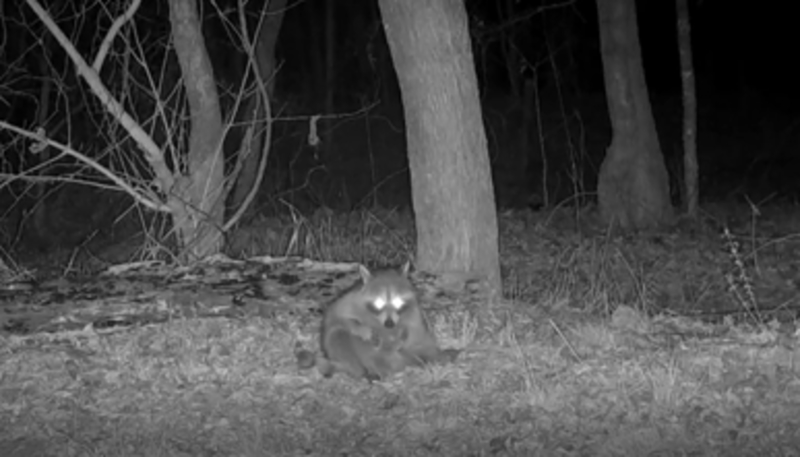
They also have a relatively weak bite force, which means they may need to use their front paws to hold food while they tear it apart. Raccoons are omnivores, which means they eat both plants and other animals. Their diet consists of a wide variety of foods, including fruits, vegetables, insects, small animals, and even human leftovers.
Surprise Visitor
This pasture cam keeping watch over horses caught a surprise visitor one day. What we see here is a bald eagle, flying just low enough for the camera to photograph it. We all might see eagles flying high above us, but we don't ever expect to catch one this up close and personal.
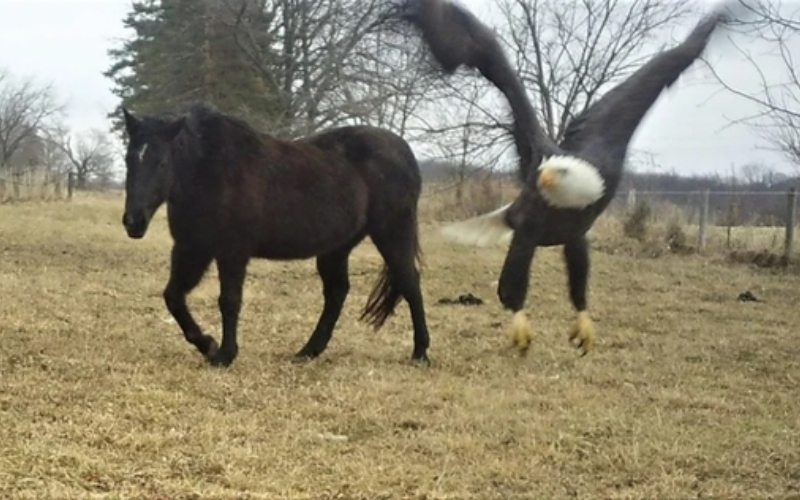
In this camera shot, the horse doesn't seem fazed at all by the sight of this incredible bird swooping down right in front of him. It's as if it's just another day on the farm for him. Perhaps he's seen this eagle before and now he's just like another animal in the meadow.
Picture Perfect
We don't always expect trail cams to take amazingly candid shots like this, but when they do the outcome is spectacular. The deer is perfectly positioned and while some might say the lens flare from the sun ruins this photo, we happen to think it makes this picture that much cooler.
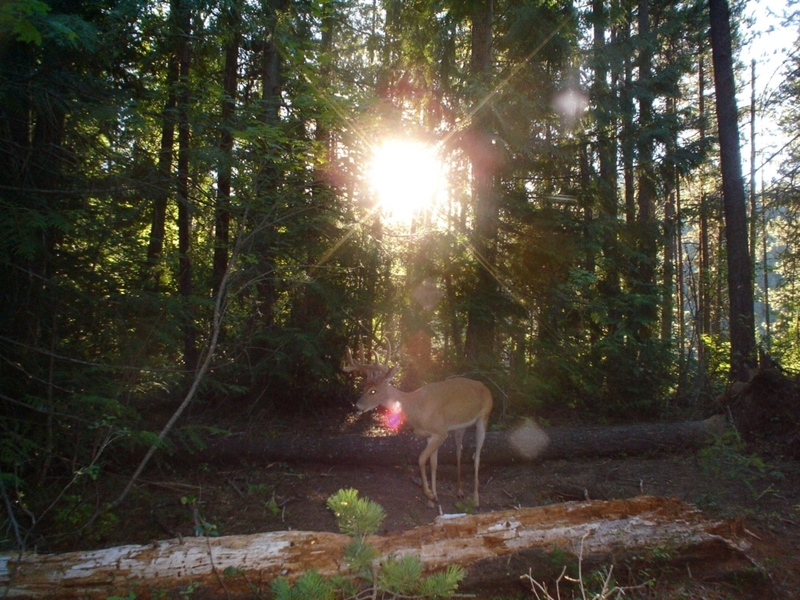
Typically taking a picture with the sun in the background doesn't get you a good photo, but this camera was lucky that the trees blocked out most of the view. To ensure your trail cam gets incredible shots like this, you might want to set it up with enough space between the camera and the natural backdrop.
Snowy Fox
With heaps of snow, we can just make out a trail of footprints and a snowy white fox in this photo. Foxes are known to be well-adapted to cold and snowy environments and can thrive because of their thick fur which keeps them protected and helps them stay warm in winter.

Their paws are also covered with fur, which helps them walk on the snow without sinking in too deeply. Foxes are also fairly decent hunters in the winter months, as they take advantage of prey that might be easier to spot against a snowy white background. They may even use the snow to their advantage while hunting.
Baby Ears
This rather strange-looking doe was photographed by a trail cam in the middle of the woods. While some deer species have evolved to have diversely shaped ears, the ears on this one look really odd. It seems she lost her ears, maybe to frostbite or it could be a genetic defect.

Her ears almost look like dog ears which might make her look like an overgrown labrador, but they certainly won't help her in the wild. Larger ears actually help them to detect predators and potential threats in their habitat. Bigger ears also allow them to regulate their body temperature during the summer months by dissipating heat.
Peek-a-Boo
While bears are intelligent and playful animals, they are not known for playing peek-a-boo in the same way humans do. While bears do engage in play behaviors, their play typically involves physical activities like wrestling, chasing, or climbing. Which is why it's so surprising to see this bear peeking at this trail cam.
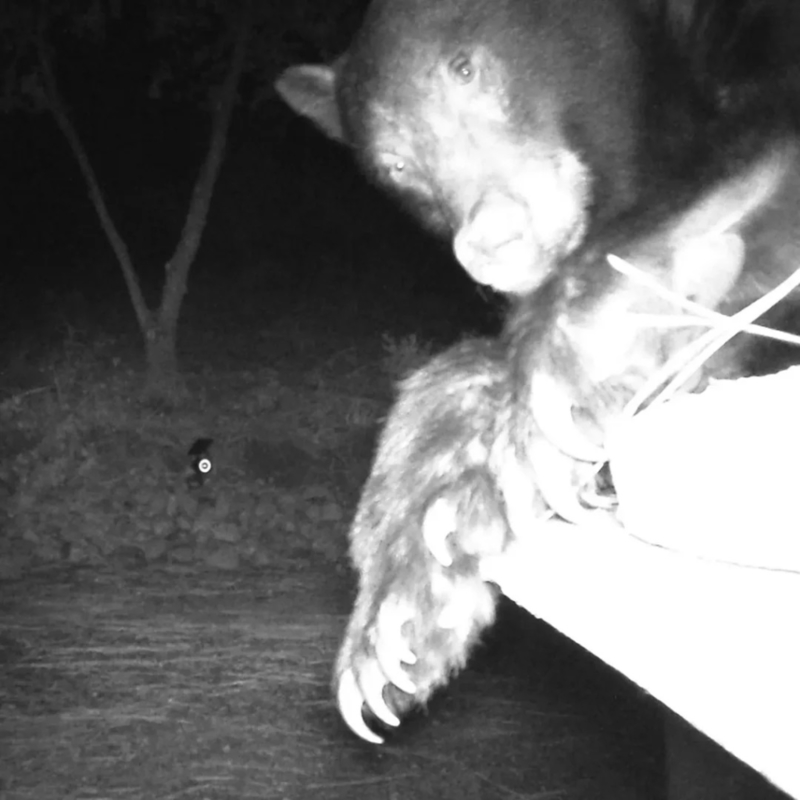
As adorable as this bear is, it's still important to remember just how fearsome these creatures can be. Though it might be tempting, it's never a good idea to approach a bear or attempt to play with one, as this can be dangerous for both the bear and humans.
Wolfing Around
Just before this trail cam got snowed over, it caught a few snaps of wild wolves hanging out in the snow. This wolf in particular made eye contact with the camera, or at least that is what it looks like. It could just be that this wolf heard the sound of the camera shutter which made it look this way.

Over time, wolves that are exposed to trail cams may become used to them. In some cases, researchers studying wolves may use camera traps or other camera equipment to monitor their behavior without direct human observation. In these cases, the wolves may soon show little or no reaction to them.
Just Saying Hi
This lone bull came pretty close to this trail cam to inspect it, before moving on in search of food. Moose bulls are generally solitary animals, and will often spend much of their time alone outside of mating season. They may even establish territories that they safeguard against other males.
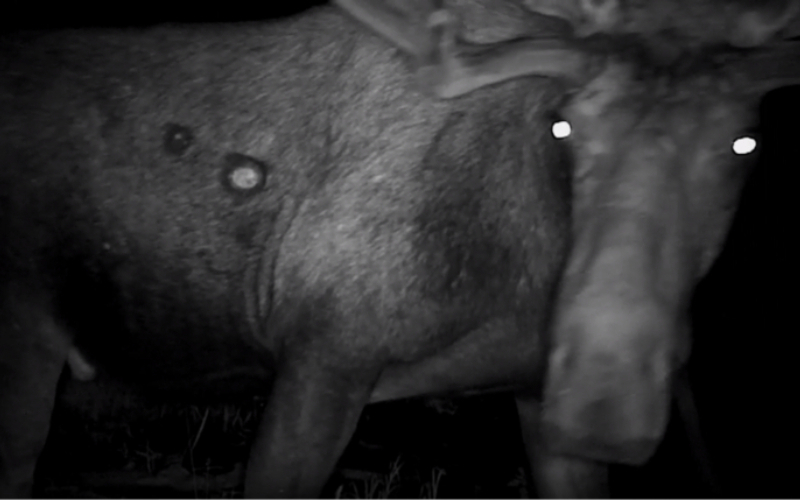
Outside of the mating season, moose bulls may roam over a large area in search of food, water, and shelter. However, it's important to note that moose may interact with other moose from time to time. They may also form small groups or pairings during the winter months when they congregate in areas with abundant food and cover.
Warts and All
Even in the wild, animals can get viruses and warts. In fact, moose are known to be susceptible to a type of wart called fibromas, which are caused by a virus. These warts can appear as small, hard growths on the skin. Fibromas are not particularly harmful to moose, and most should eventually go away on their own.

Fibromas are most commonly seen in young moose, like this one, and are thought to be transmitted through contact with other infected animals. They are not contagious to humans but still, if you observe a moose with visible warts or growths, don't assume you can get close and pet it, it's still a wild animal after all.
Just Strolling By
The temperatures in which this photo was taken were -5 degrees Fahrenheit. Now that's cold! The air must have been crisp and the forest looks quiet and peaceful, save for the crunching of snow underfoot. It was a perfect winter's day, and this elk knew it. With graceful strides, she made her way past this trail cam, alongside the snow-covered mountain.
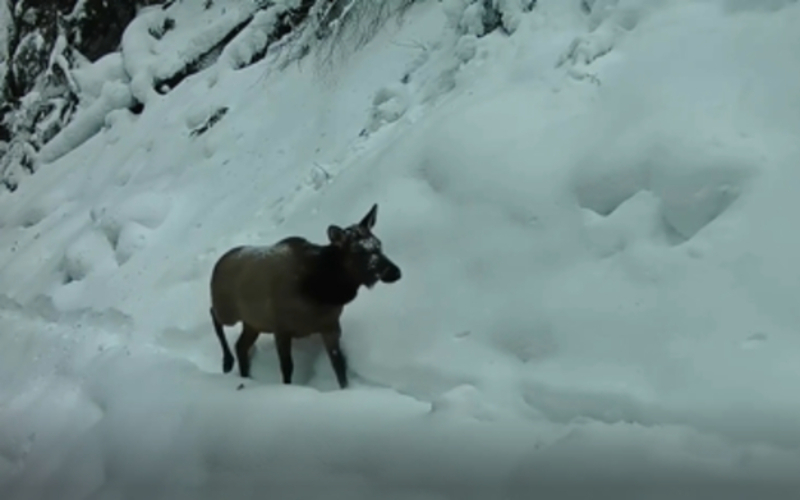
For this elk, the snow is not an obstacle, but an invitation. An invitation to explore, to play, to simply be. You see, elks are well-adapted to living in cold and snowy environments. Their thick fur provides insulation against the cold, and their large hooves act like snowshoes, allowing them to move across deep snow without sinking.
Meanwhile...
Have you ever thought you smelled something smelled strange when you went out to your backyard? You tell your partner about it but they're not sure what it could be. So you set up a trail cam and your suspicions are correct! A skunk has been visiting your wood pile.
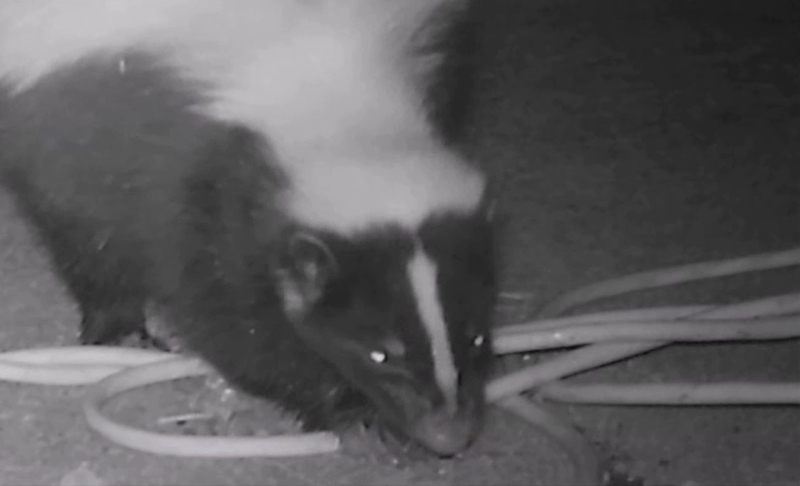
Skunks are adorable and even interesting creatures, but they can also be a nuisance when they dig up lawns or gardens or spray their odor. The last thing you want is to run into one and have them spray you. That being said, they are beneficial to the environment as they help control insect populations.
Self-Care
Watching this big buck have a good time in the mud is such a delightful sight to see. He's clearly unburdened by the worries of the world, which can be a reminder that we should all enjoy the simple pleasures of life. It was as if he was taking a break from his daily struggles and indulging in some much-needed self-care.
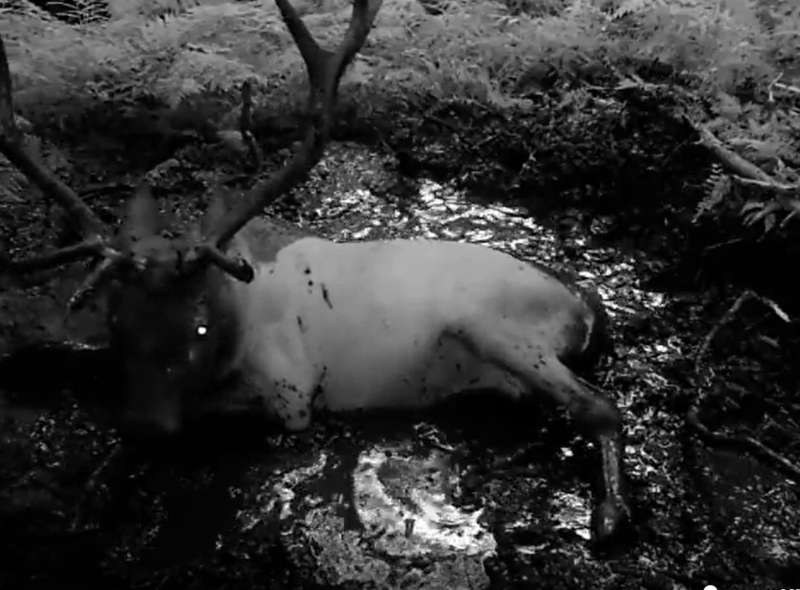
We don't know about you guys, but nature has a way of making us feel refreshed. Just as we watch this buck enjoying a little fun in the mud, we're reminded that being out in the great outdoors can also create a sense of awe and wonder that connects us with something larger than ourselves.
Defending It's Nest
Here we see some footage of a brush turkey defending its nest from a goanna in Queensland, Australia. Brush turkeys, also known as Australian brush turkeys, are known for their distinctive appearance, with black feathers and a bright red head and neck. One of the most unique characteristics of brush turkeys is their impressive nest-building abilities.
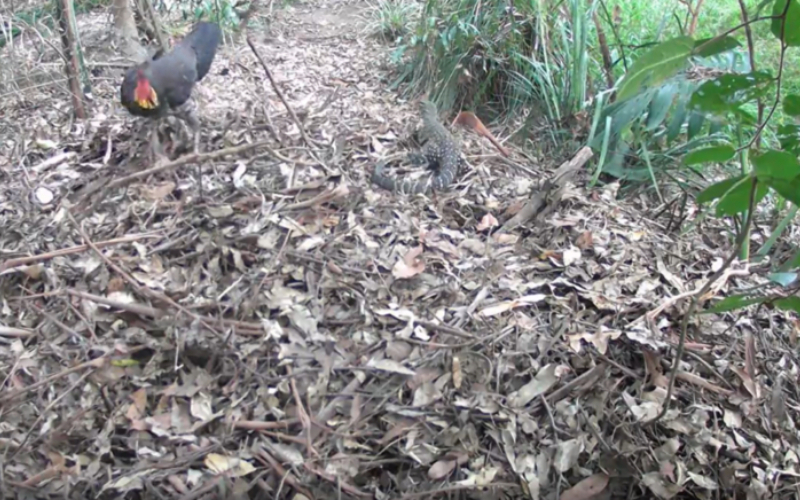
Unlike most birds, brush turkeys do not build traditional nests in trees. Instead, they build large mounds of organic matter, such as leaves, twigs, and soil, which can be over two meters wide and one meter high. Fortunately, this turkey was able to protect its nest from this goanna and stop him from eating her eggs.
Talking Elk
If elks could talk, what do you think they would say? It could be that this guy is calling out to his friends or looking for a mate. Or could it be that he's happy to be alive and expressing his gratitude? On the other hand, elks might also express their frustration with the many challenges they face.

You know, things like having to deal with predators like wolves and bears. They could also lament the fact that their large size and slow movement make them easy targets for predators and hunters. We're not sure really, but we can imagine and speculate that they would have much to say about their experiences in the wild, both good and bad.
A Pair of Wolves
For some people, it's their dream to see wolves in the wild. Yes, they are beautiful creatures but they are also incredibly dangerous and skilled predators. This photo from a trail cam reminds us of that and that for some people, coming face to face with a pair of wolves is more like a nightmare.

If you come face to face with a pair of wolves, it's important to stay calm, which will probably be difficult considering the circumstances! Do not turn your back on the wolves or run away, as this may trigger their predator instincts. Raise your arms and stand on your toes to make yourself look bigger as this can help discourage them from coming closer.
Family Squabble
In the full video from which this screengrab is taken, you could see that the hysterical bear here is actually battling another bear. These two youngsters could be siblings. It's not often that you get to see bears fight as they tend to avoid conflict with other bears. It's through these kinds of family squabbles that you can see siblings go their separate ways. Plenty of other species behave similarly.
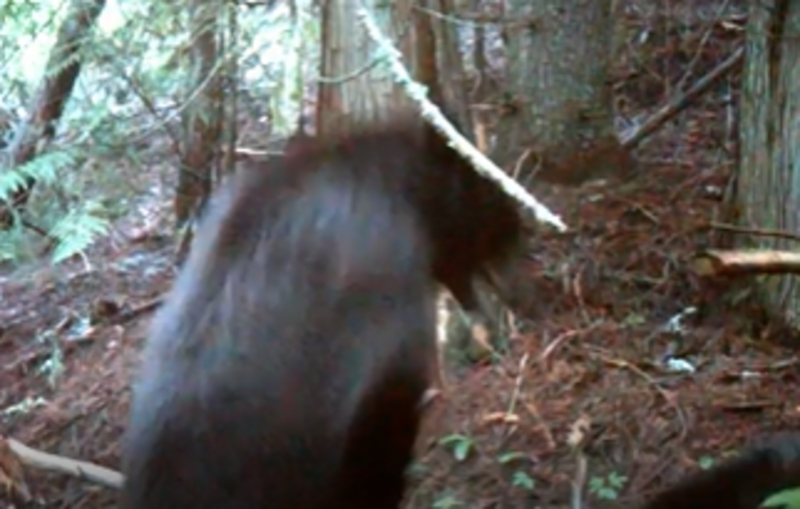
While they may have grown up together for the last two years or so, there comes a point in time when they get more aggressive and as is natural for bears, they eventually go their separate ways to lead a more solitary life. The trait evolved because of the efficacy of resource acquisition in the past among solitary bears.
Really Close up
Did you know that cougars are the largest wild cat in North America? They can weigh up to 200 pounds and measure up to 8 feet long, including their tail. This big cougar was pretty curious about this trail cam, so much so that he (or she) got really close to it. As mentioned in this article, cats are incredibly curious animals.
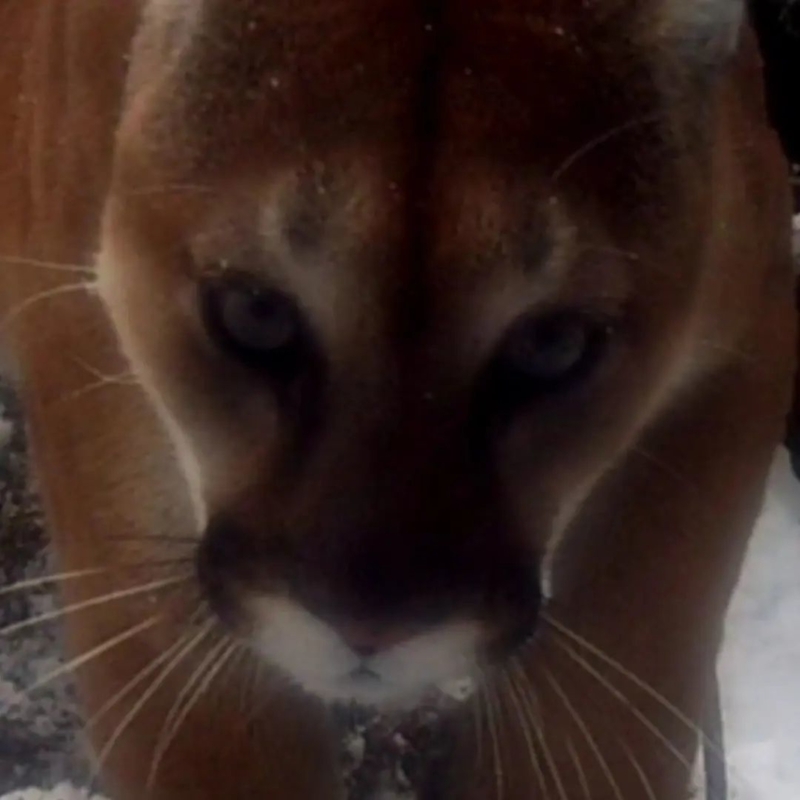
Despite their size, cougars are elusive animals that are rarely seen by humans in the wild. They are excellent climbers and manage to scale trees just to avoid detection. Cougars are also most active at dawn and dusk when they are hunting for prey, which makes it difficult for us to spot them.
Basking in the Sun's Rays
This trail cam caught some amazing footage of a fox basking in rays of sunlight. Foxes are strictly nocturnal creatures, but here we can clearly see this fox enjoying some of the sun's warmth. Typically, we'd expect to see some reptiles trying to get some warmth from the sun, but not foxes.

It could be that this was taken on a cold day and this fox just wanted to warm up a little before going back to his den to sleep. During the day, foxes usually rest to avoid extreme heat or cold temperatures and end up hunting during the night, as they have excellent night vision and can hear very well.
Some Salt Licks
At first, we couldn't tell what was happening in this photo. It first seemed that these dudes were chewing on the bark of this tree, but upon further inspection, we see that it's actually a salt lick. Salt licks are set out for animals to supplement their diet with necessary minerals, particularly sodium, which is important for maintaining proper bodily functions.

In the wild, animals may not have access to enough natural sources of salt, particularly in areas where the soil is low in minerals. Providing a salt lick can help animals maintain their health and well-being, especially during times when food is scarce. Salt licks are commonly used to attract and manage wildlife for observation purposes.
Young and Free
This young moose was checking out this cabin in the middle of the woods. Moose typically stay with their mother for the first year of their life, until the next calving season. During this time, the mother teaches her offspring how to find food and avoid predators, and the young moose gradually becomes more independent.

By the time a young moose is about one year old, it should be weaned from its mother and able to survive on its own. This is when it will leave its mother's side and disperse into the surrounding area to find its own territory and establish itself as an independent individual.
Flock of Birds
This beautiful scene of a flock of birds flying away is not only sublime but also a little eerie. It could almost be an opening scene for a horror movie. If we're correct, it looks like this could be a plague of grackles. Yes, a group of grackles is called a plague!
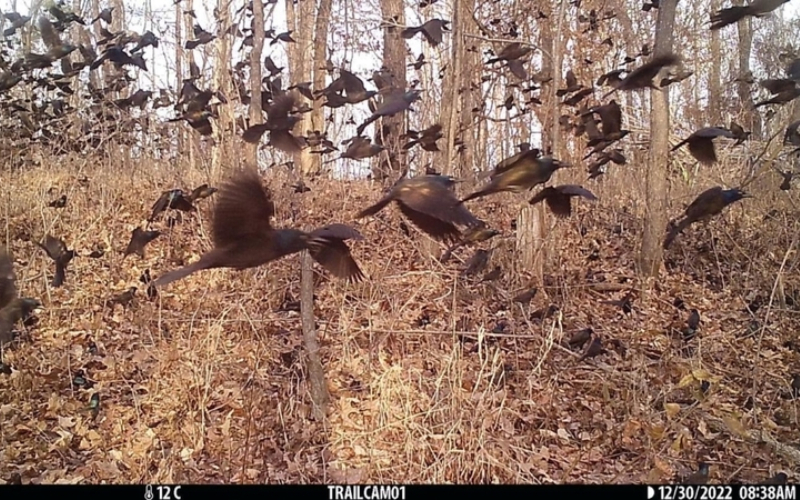
There are several species of grackles, but the most common in North America is the common grackle. While grackles are sometimes considered to be pests due to their habit of raiding agricultural fields, they are also important members of many ecosystems, serving as seed dispersers and cleaning out the woods of acorns.
Caught in the Lights
This buck looks exactly like a deer caught in headlights, except he's caught on a trail cam. When a deer is caught in headlights, it typically stands motionless, its body tensed and its ears pointed forward, as it tries to assess the situation and determine whether to flee or stay put.
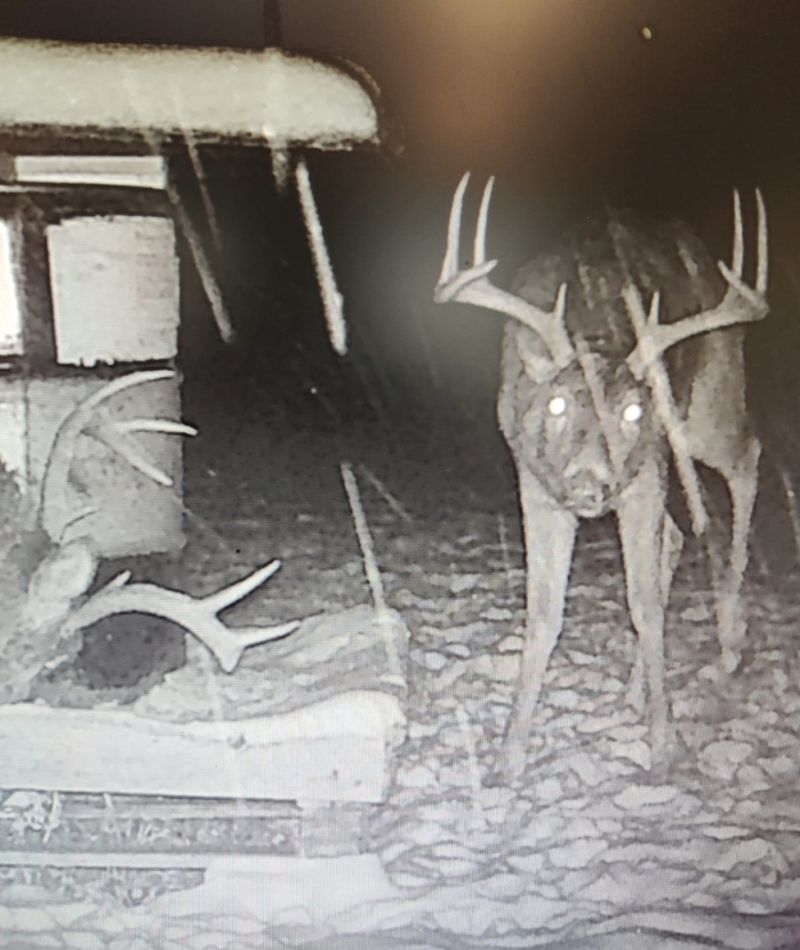
Typically, the eyes will appear wide and alert, reflecting the light from the headlights, and its body may be slightly crouched or ready to bolt as we can see in this photo. This is a common behavior among deer and is caused by the bright light temporarily blinding the animal and confusing its senses.
Mid-Spring
Here we have an adorable photo featuring a deer that's been captured mid-spring! It almost looks like it's posing for the camera, like a ballerina, proud to display its athleticism. Deer are adapted for running and jumping over uneven terrain, and their movements are often quick and agile, as they navigate through forests and fields.

Deer can also be graceful in their movements, particularly when running or leaping. Ballerinas are also known for their grace and fluidity, as they move across the stage with precision and elegance. Is it any wonder that we're comparing deer to ballerinas? They're basically a group of ballet dancers navigating their way through the forest.
Follow the Leader
As many of you might already know, wolves are highly social animals that live in hierarchical packs, which are usually led by a dominant male and female pair. The alpha pair, or alpha male and alpha female, are the highest-ranking wolves in the pack. They are typically responsible for leading the pack.

It's certainly worth noting that recent research has challenged the concept of the alpha pair as the highest-ranking wolves in the pack. Newer studies are now suggesting that wolves may have a more fluid and cooperative social structure, in which each wolf has a unique role to play in the pack.